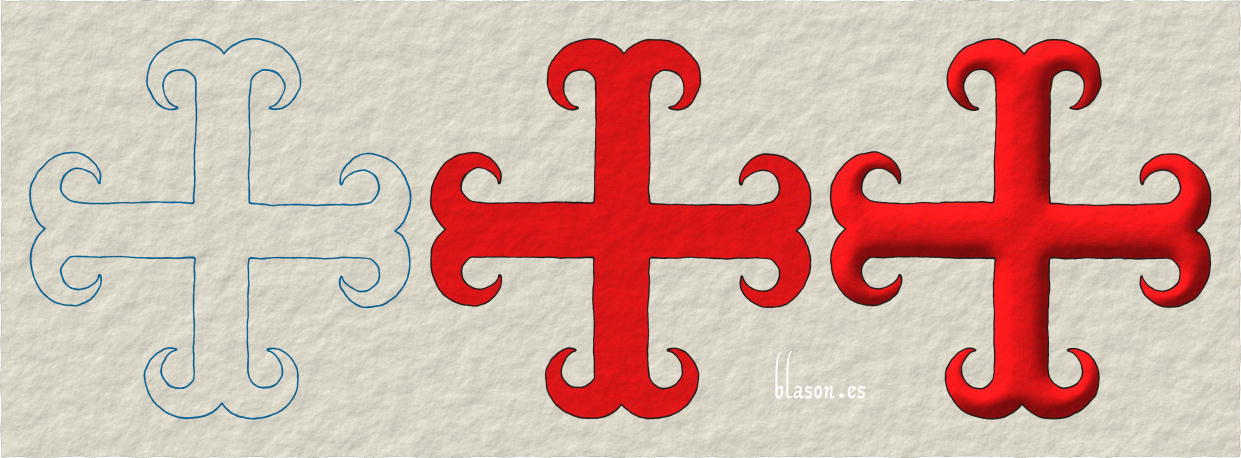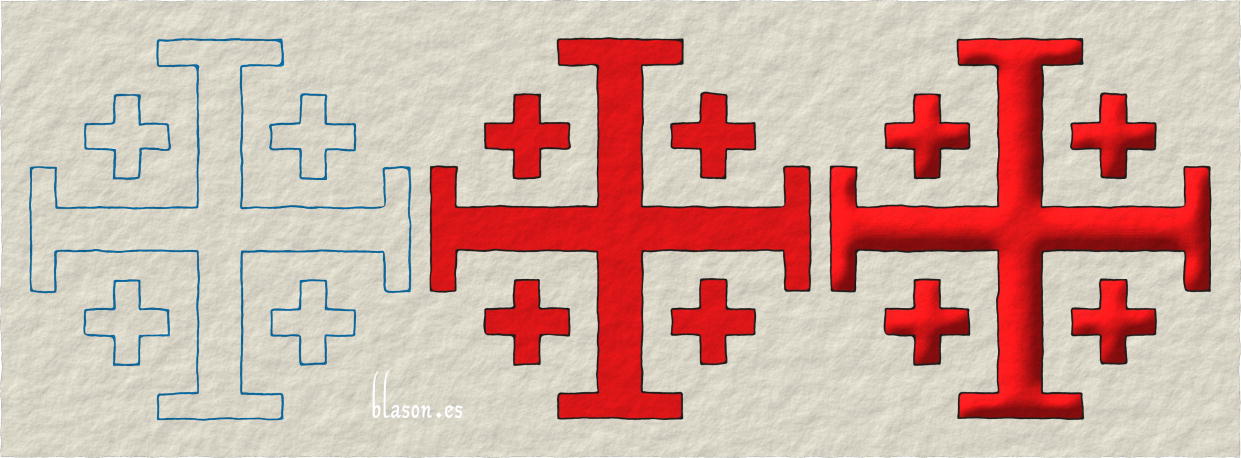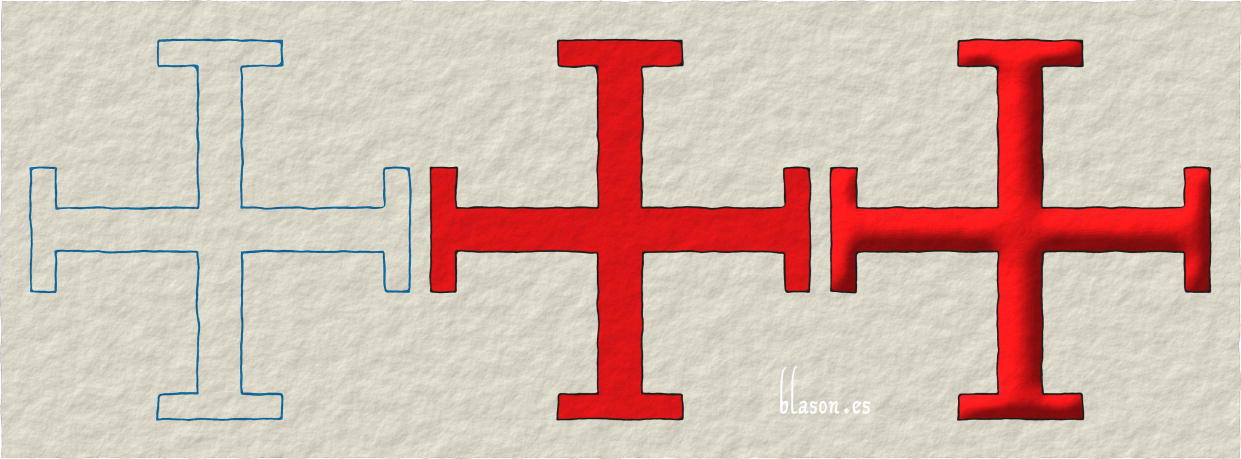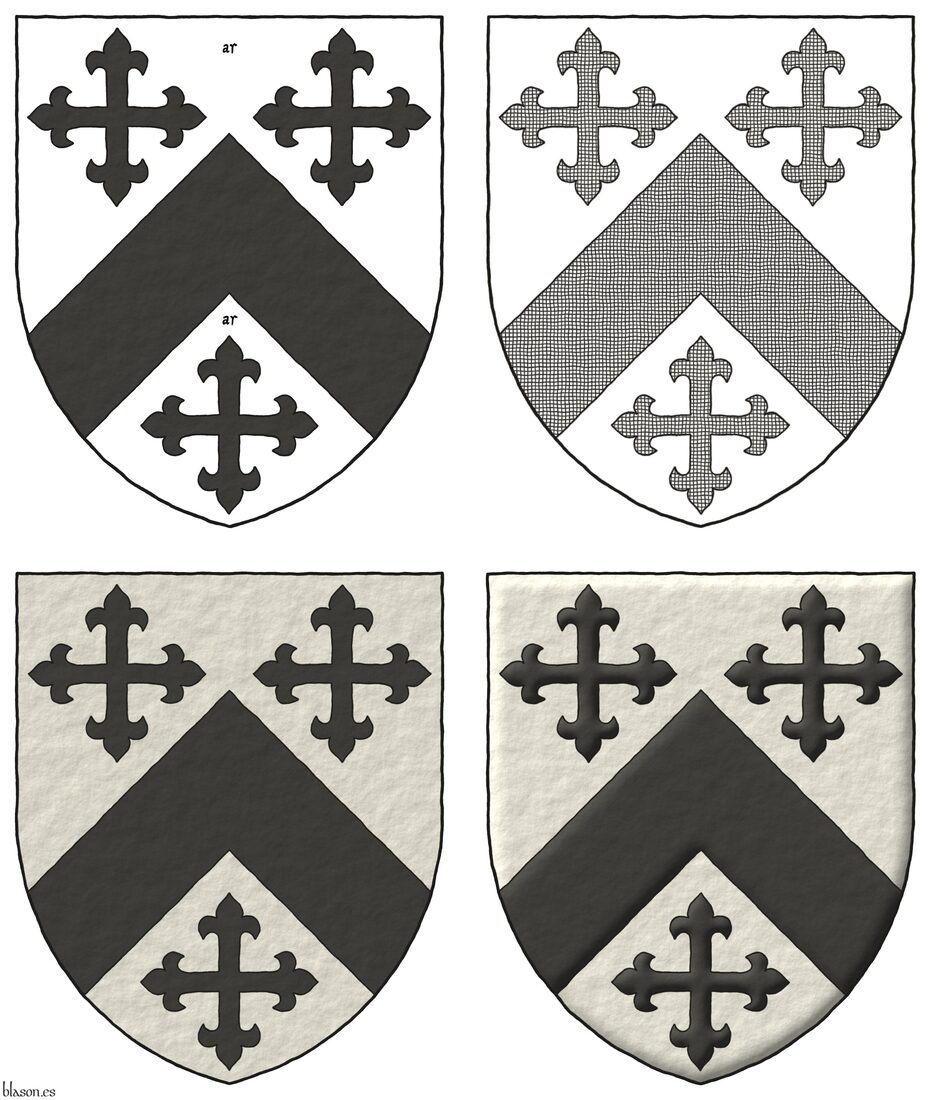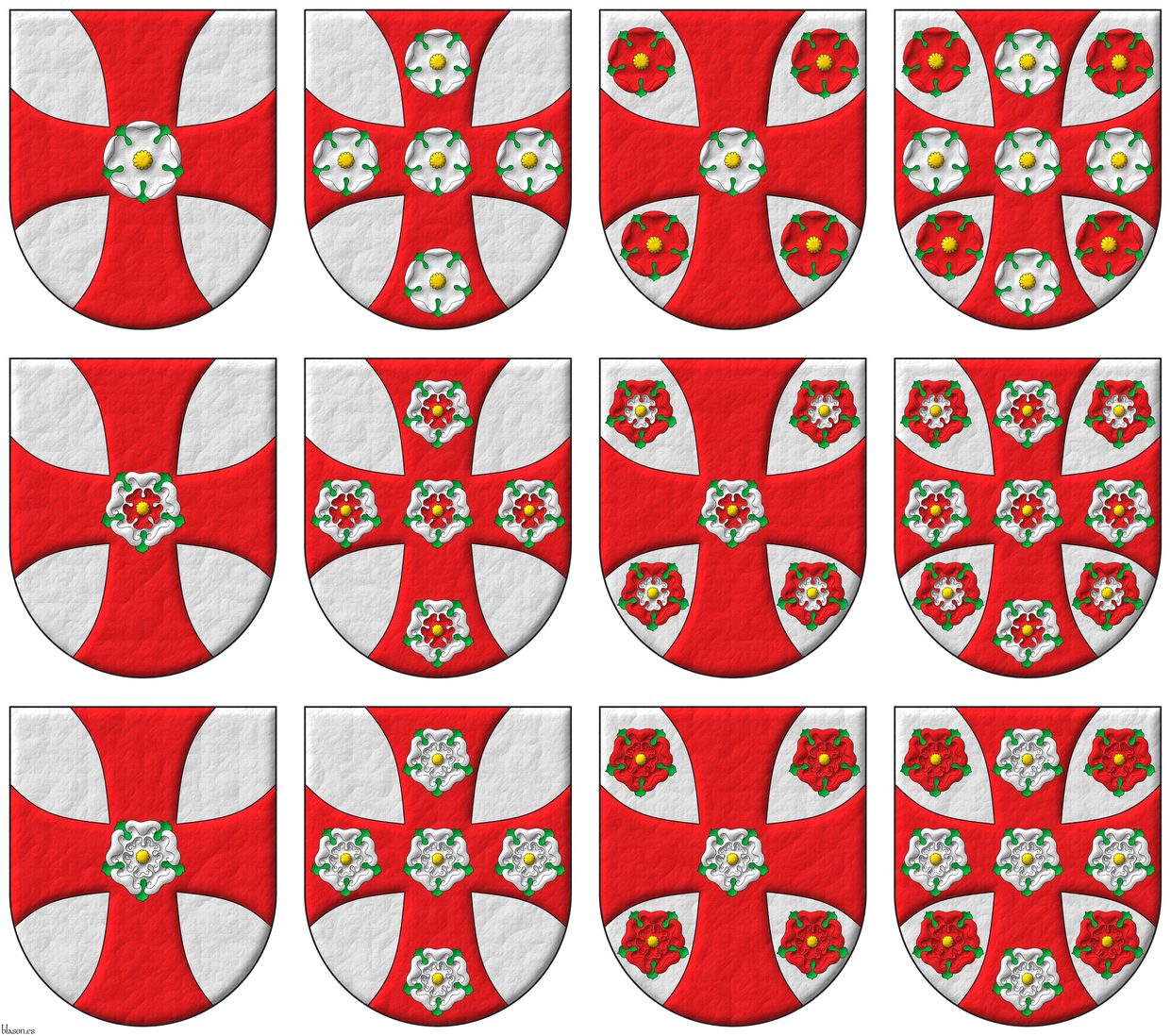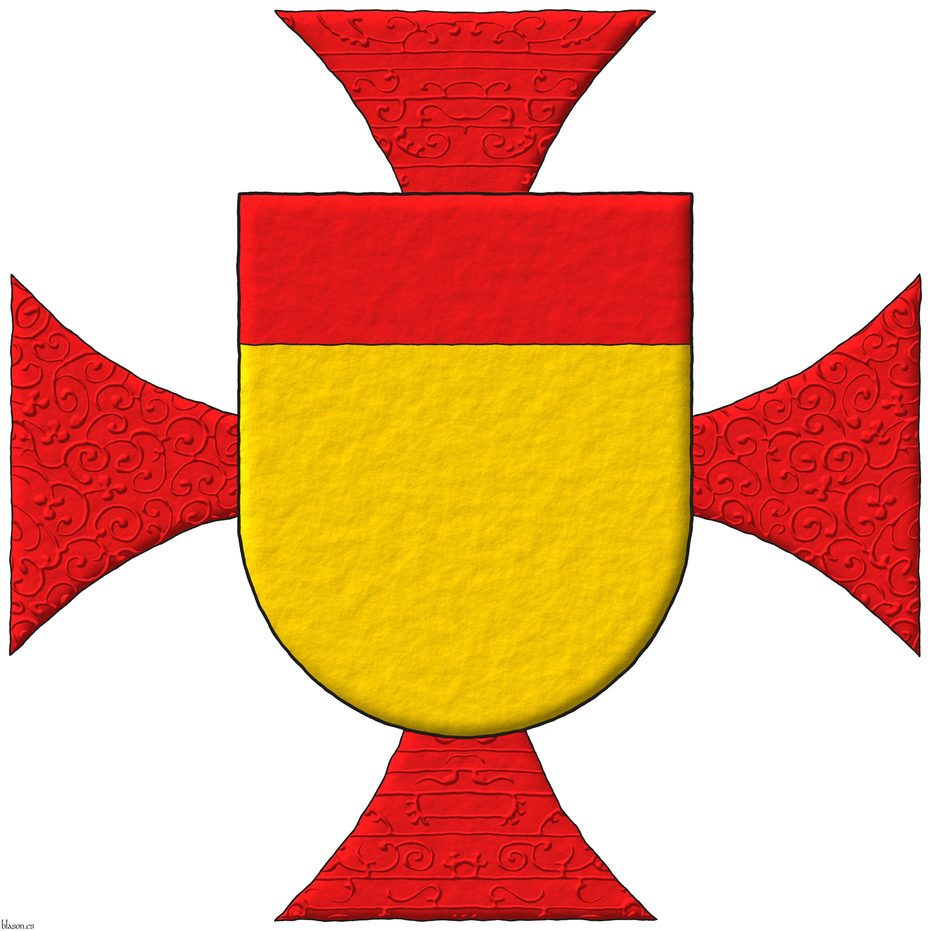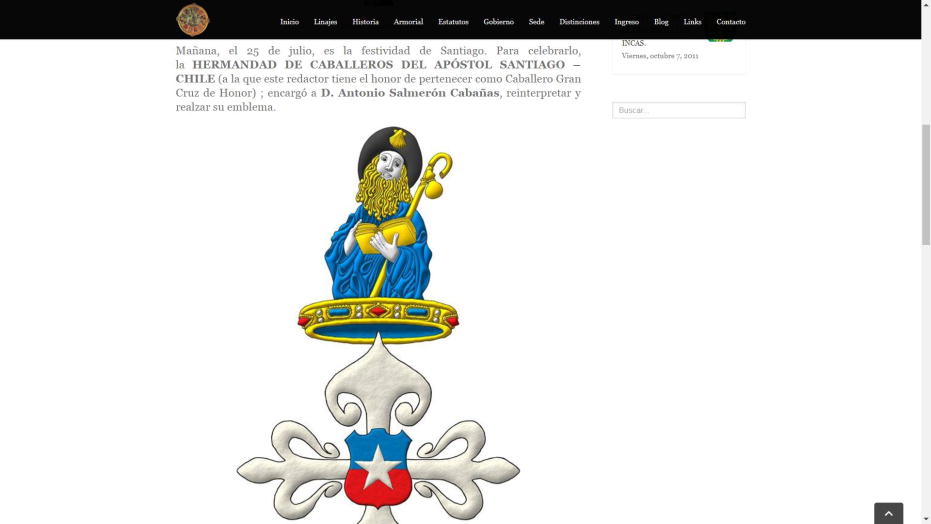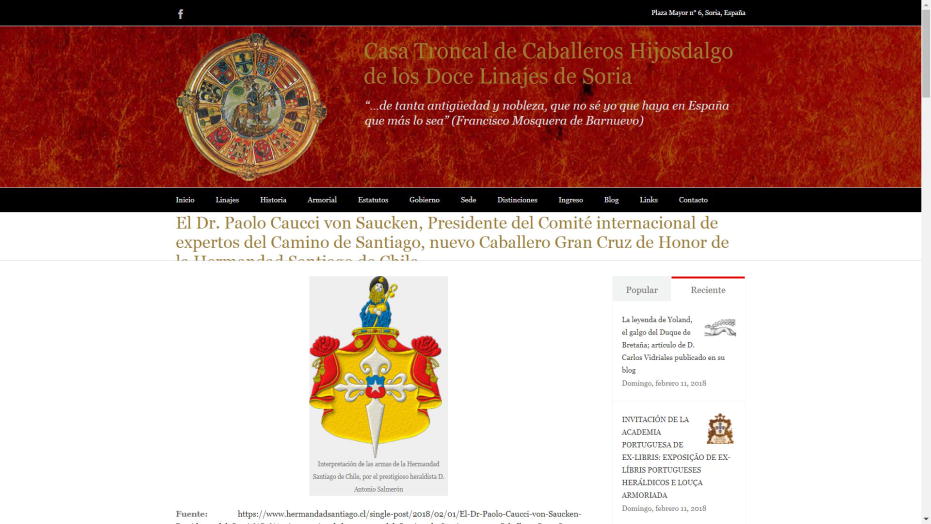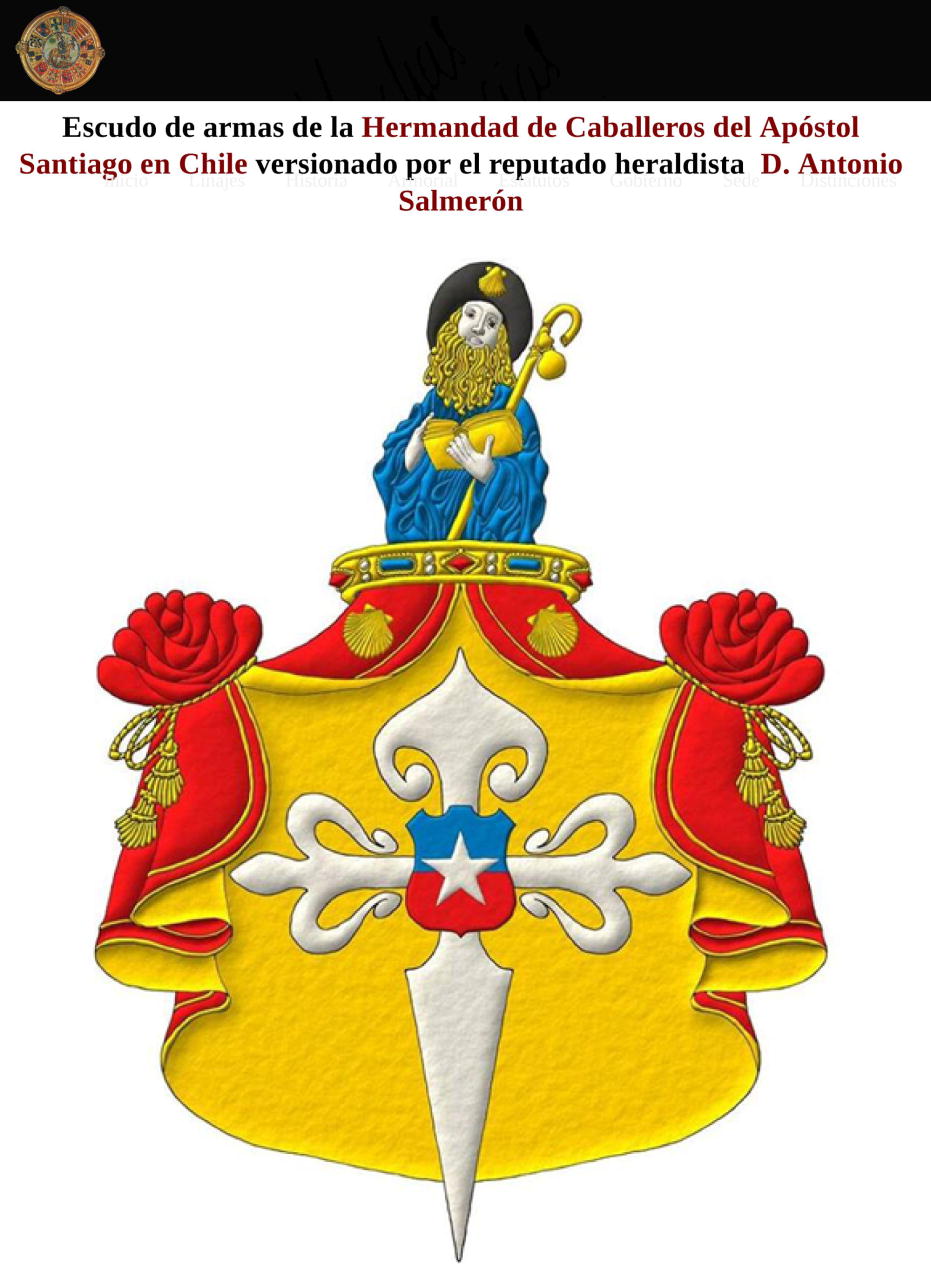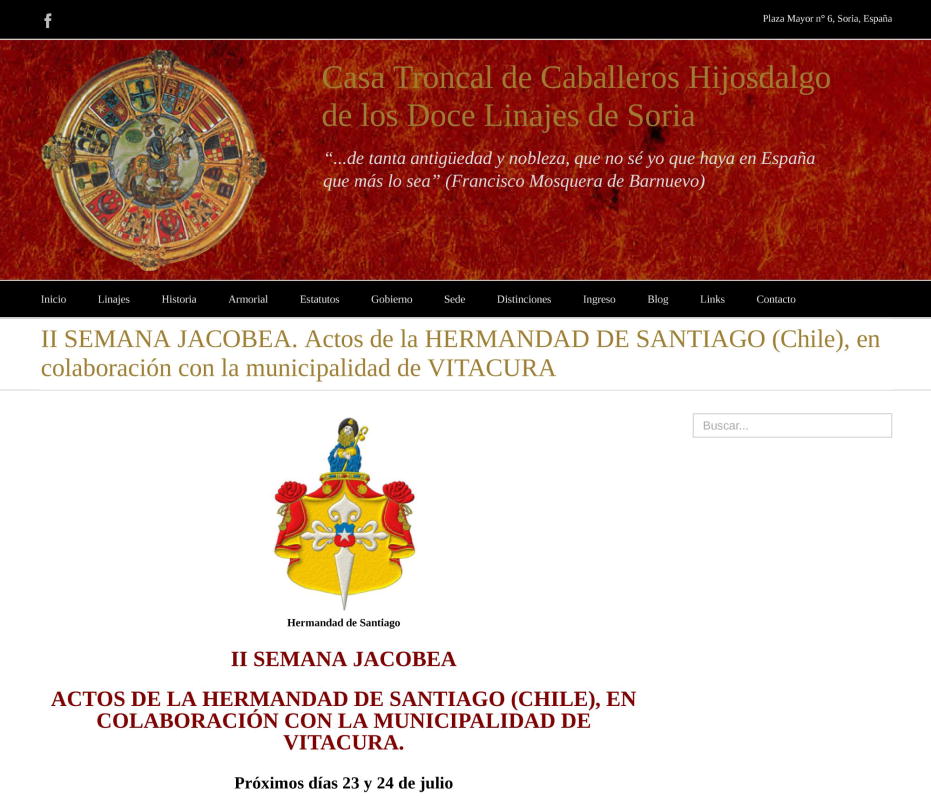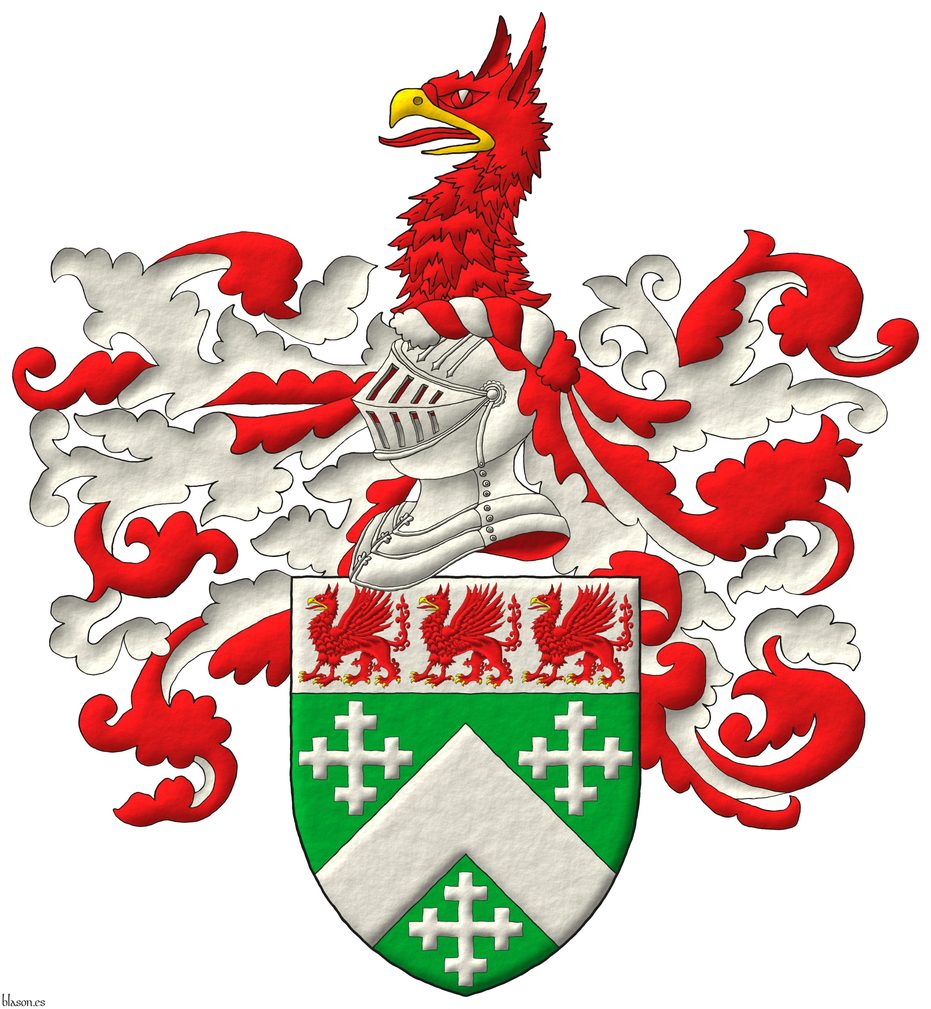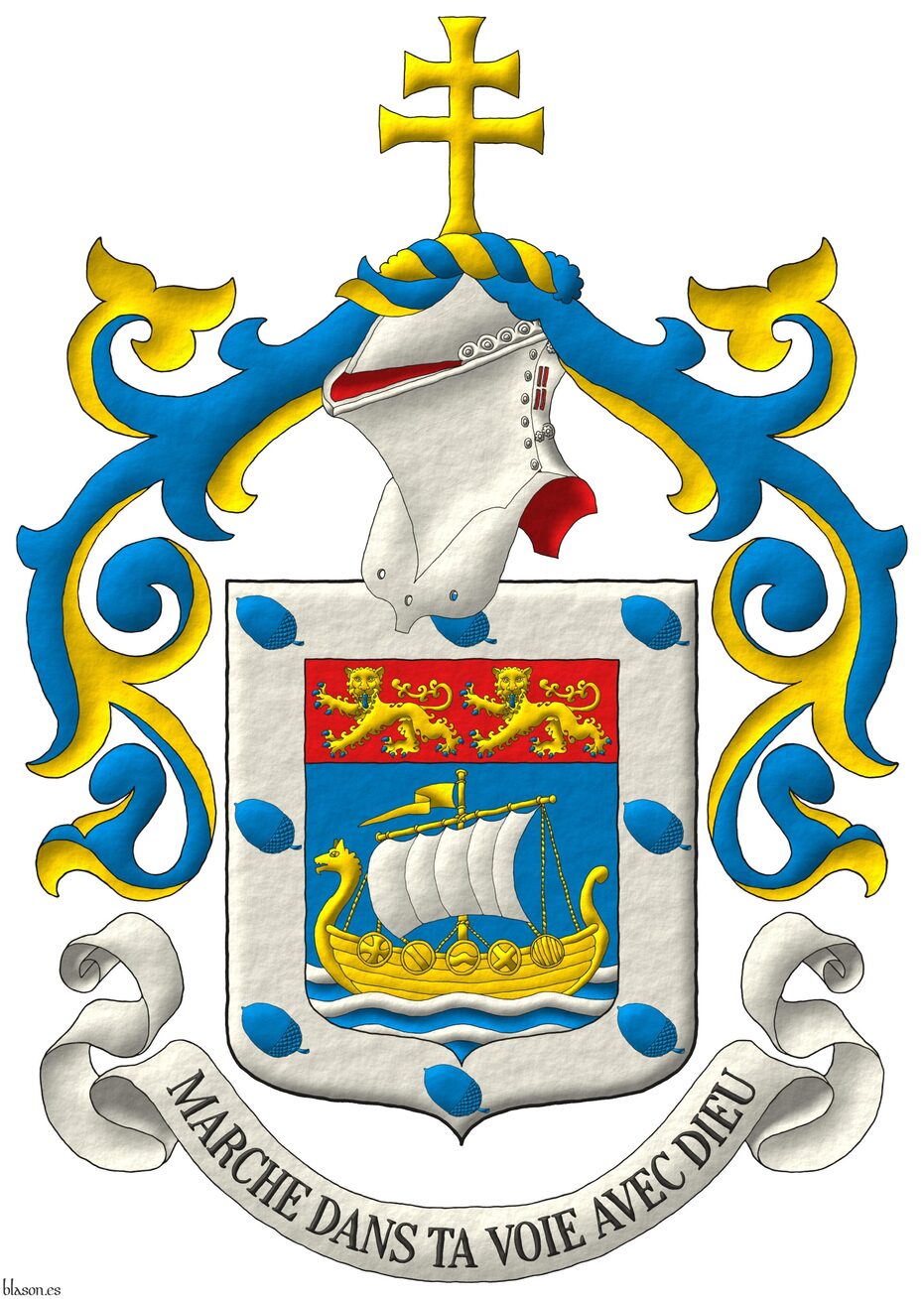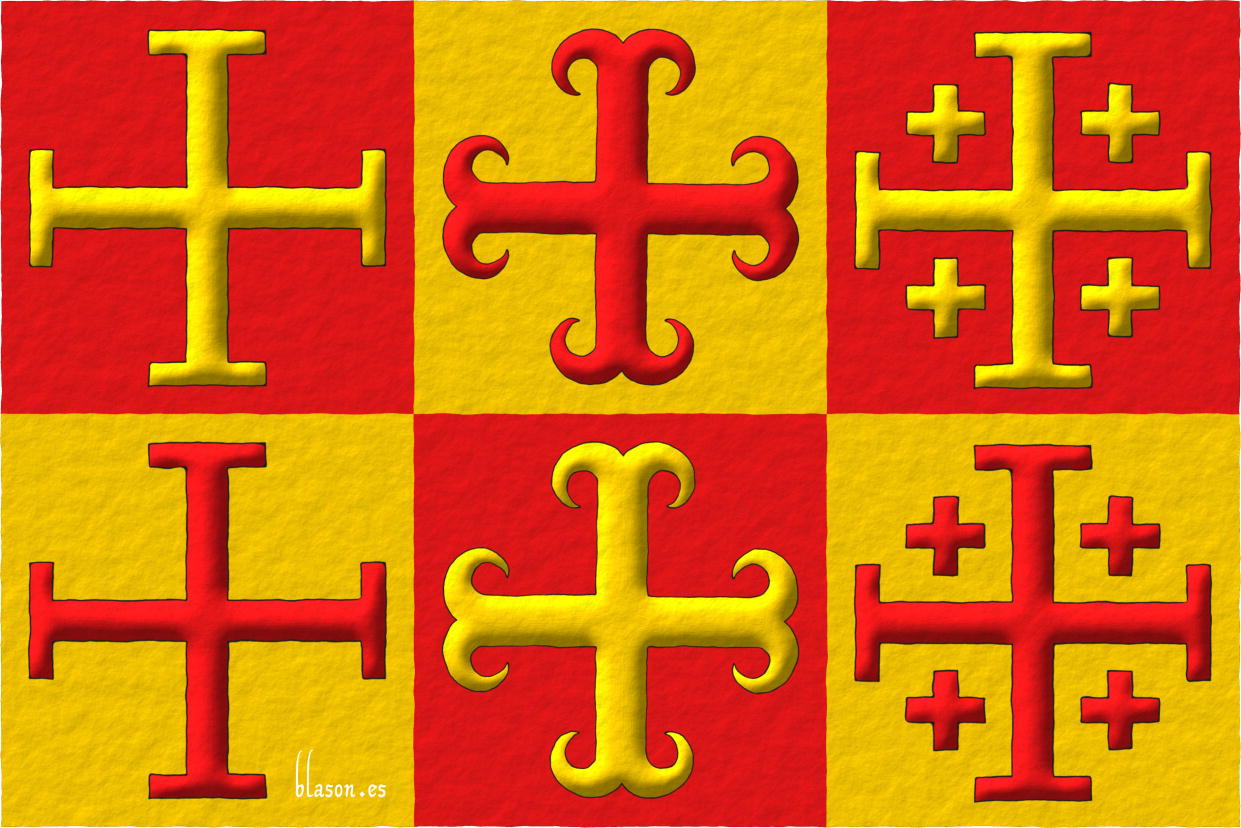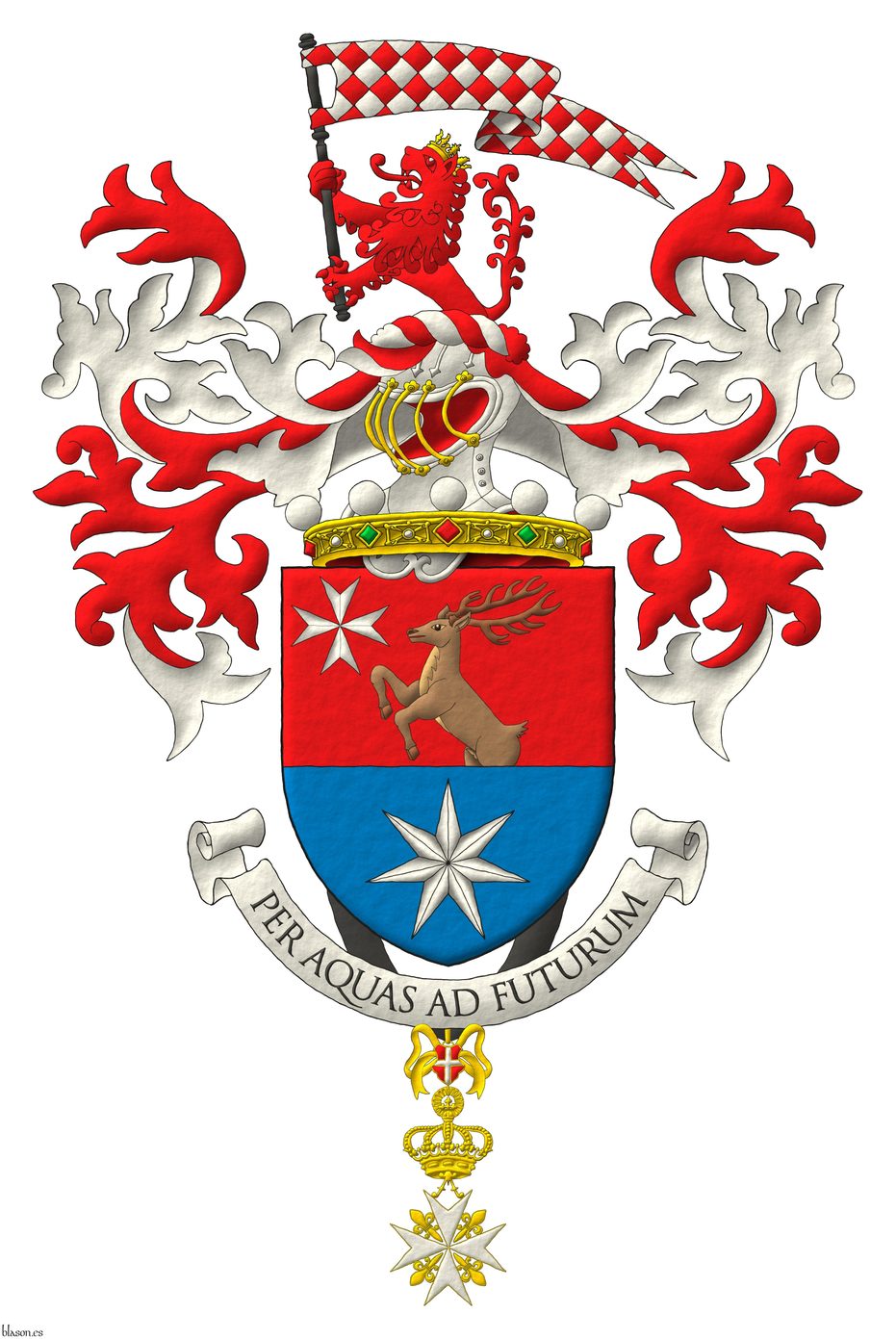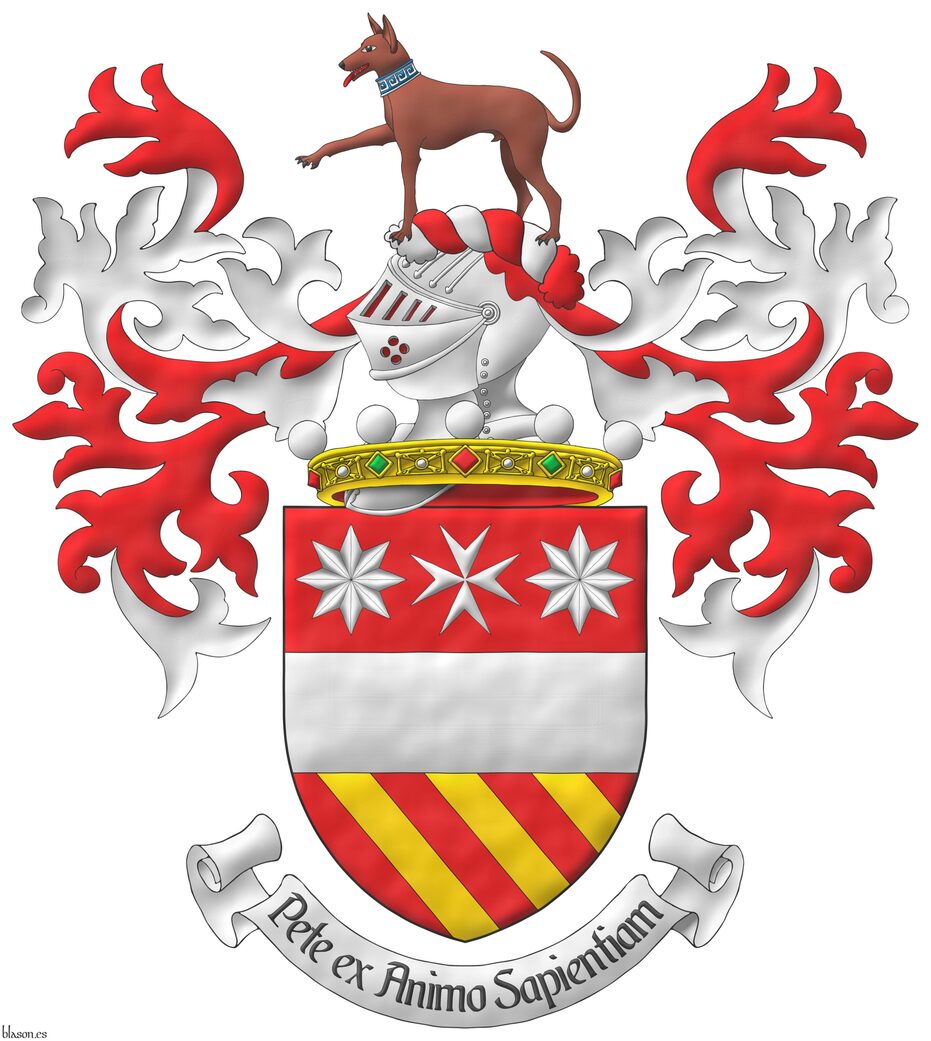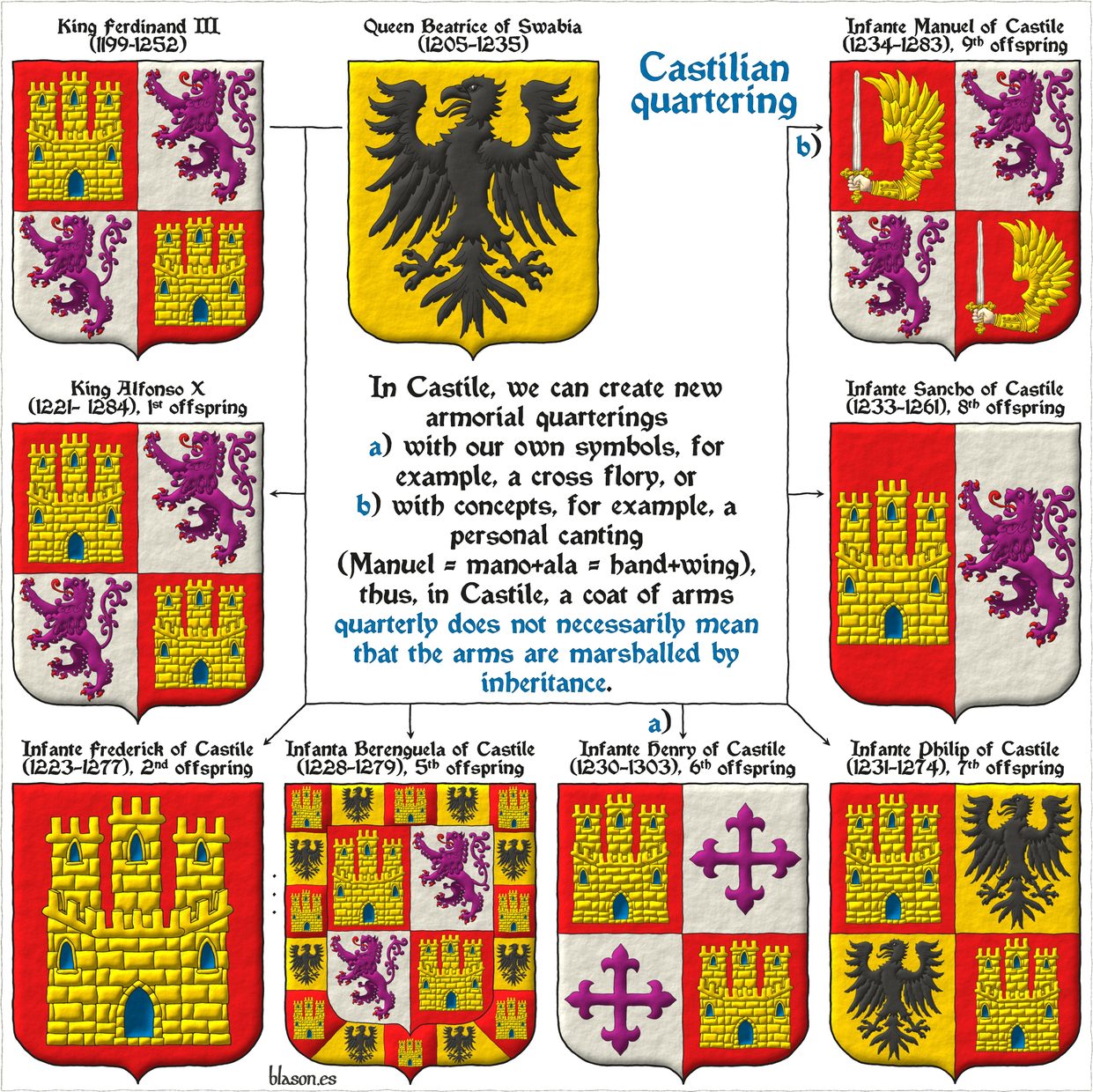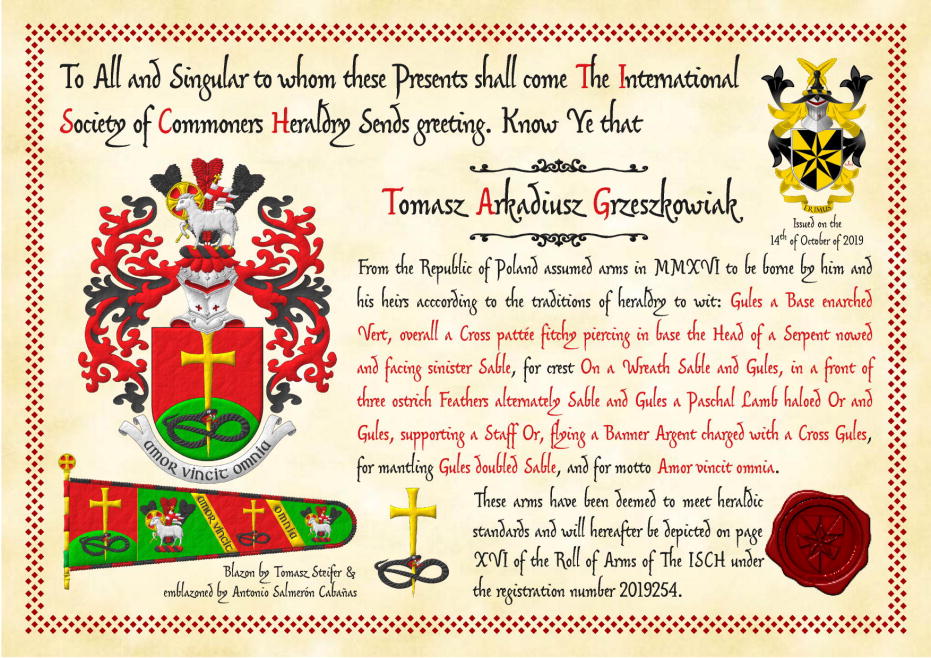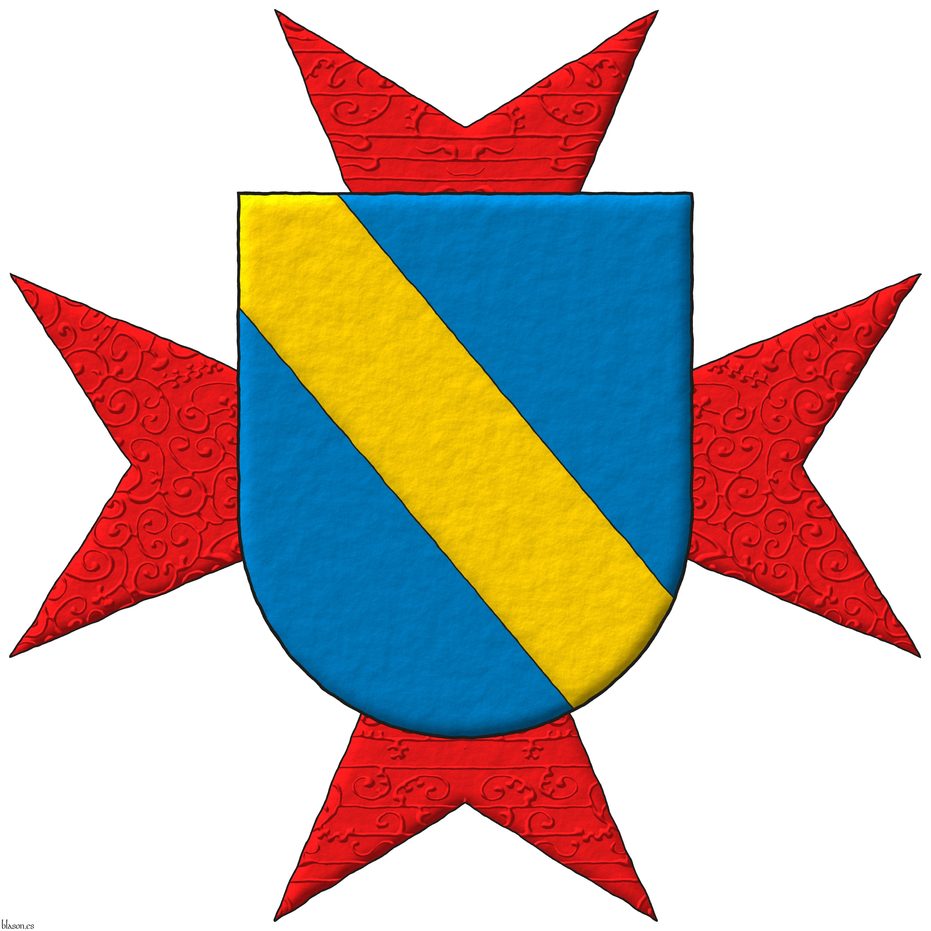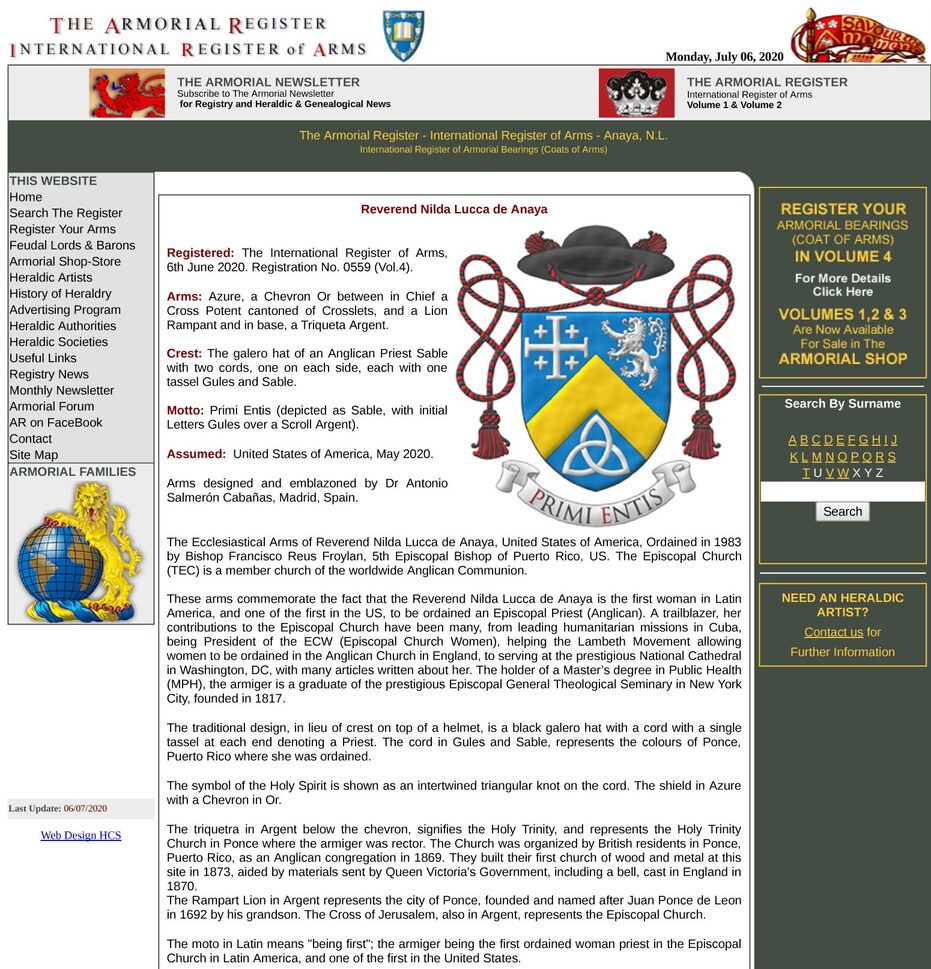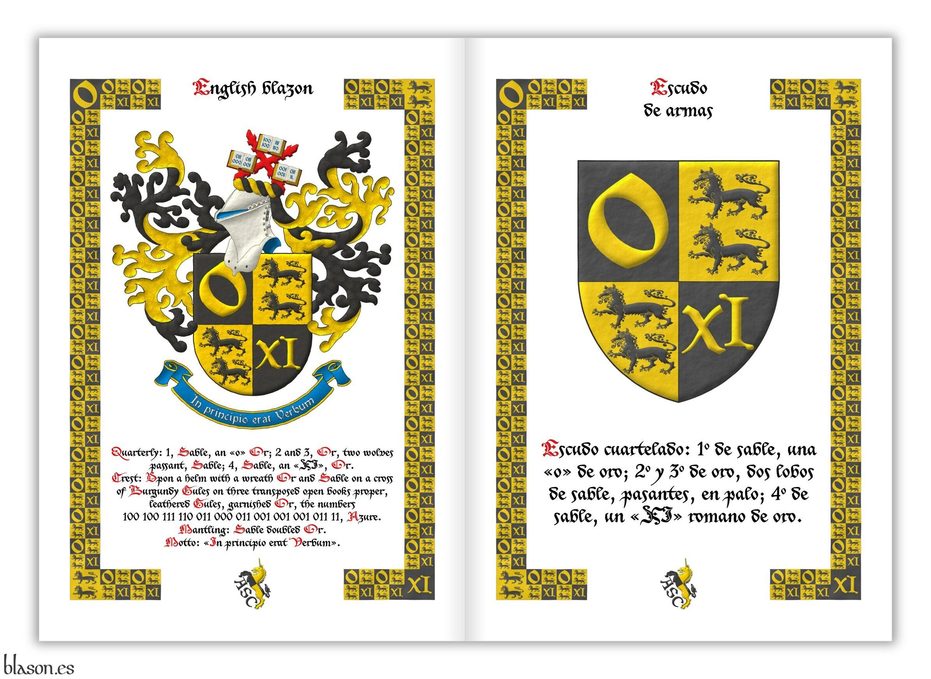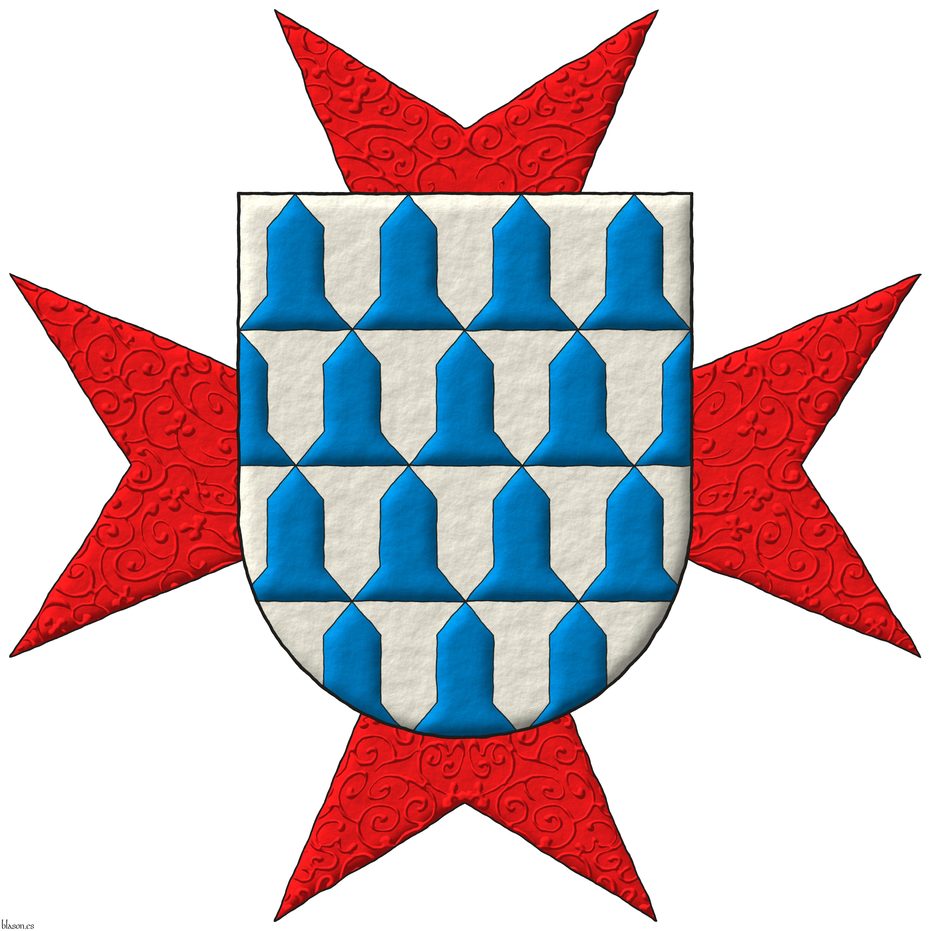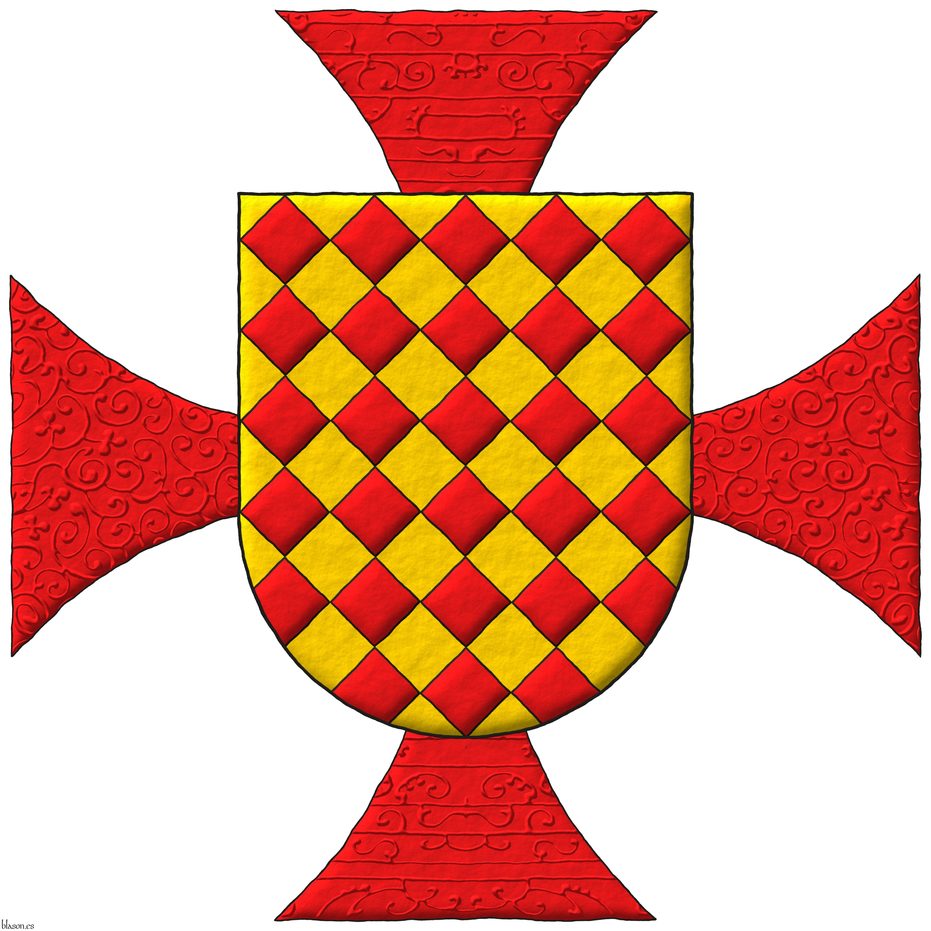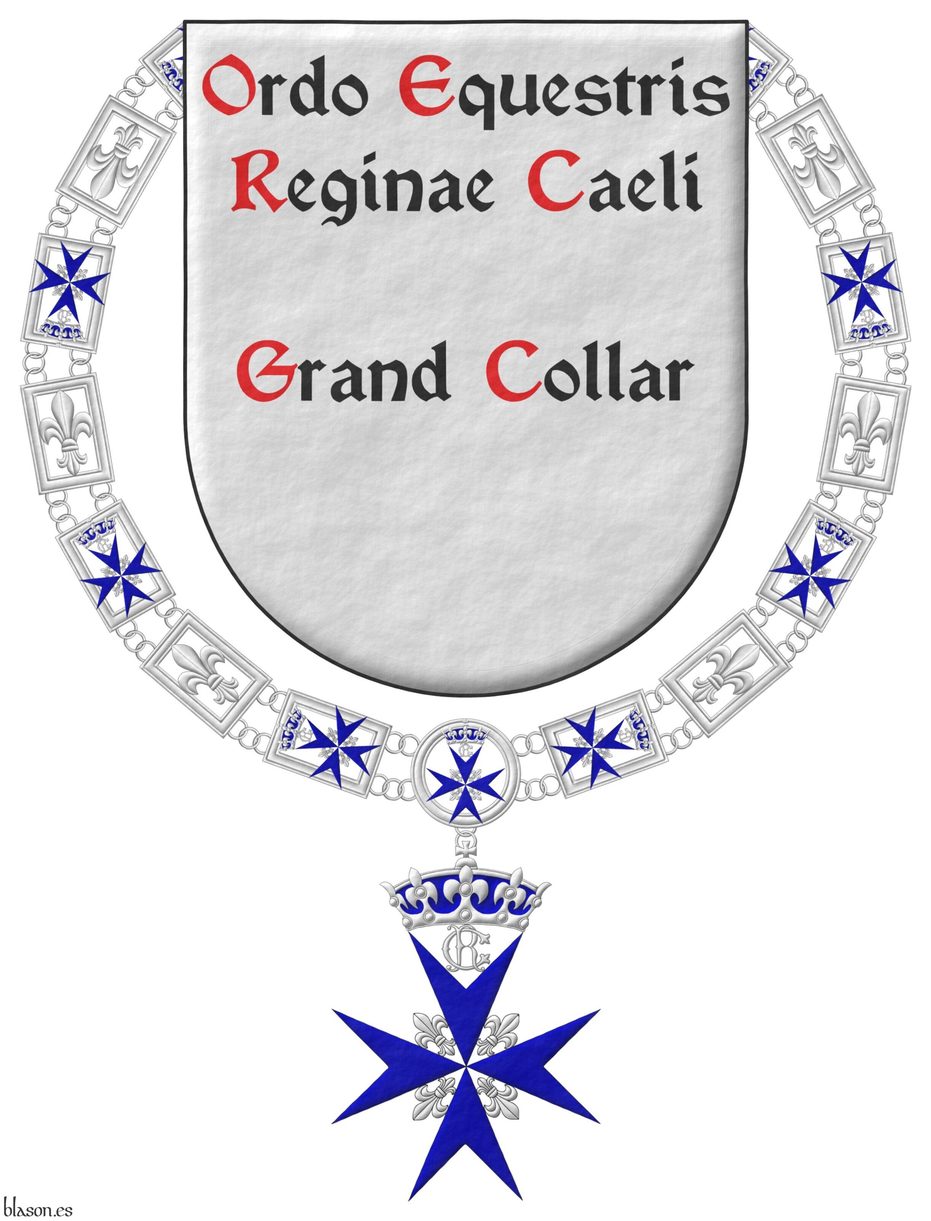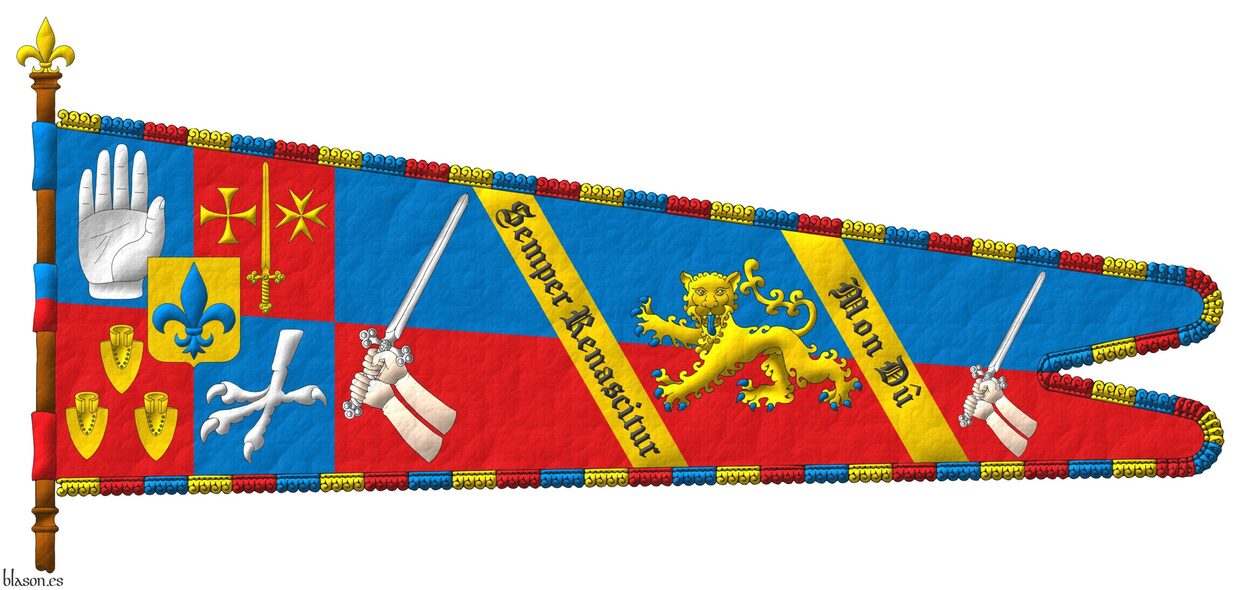Cross couped


![Ver [Alcantara, Order of] en instituciones citadas. Fortaleza de oro y mazonada de sable.](../css/Fortaleza.Institucion.png)
Alcantara, Order of
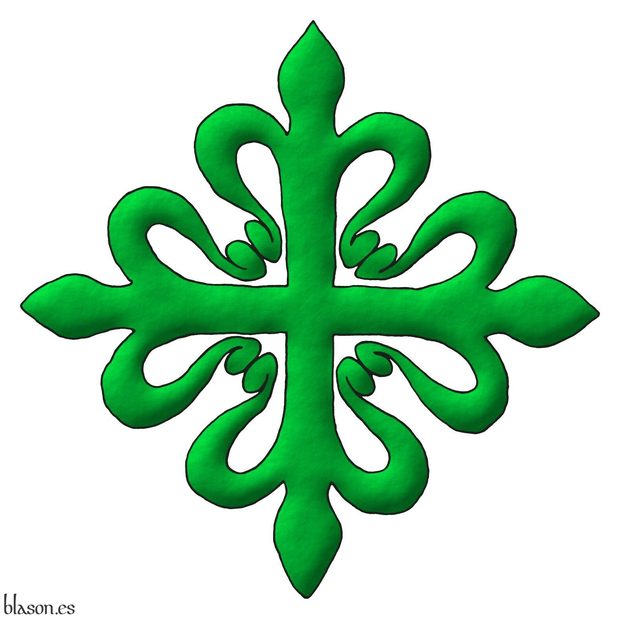
It was founded by Count Henry of Burgundy as a military and religious order, in the year 1093, in Beira Alta, Portugal, near the river Côa with the initial name of «Ordem de São Julião do Pereiro» ~ Order of Saint Julian of Pereiro.
In the year 1214, the defense of the city of Alcantara after its conquest was entrusted to the Order of Calatrava, but in 1218 the Calatravans relinquished it due to Alcantara being far from Calatrava.
To defend Alcantara, King Alfonso IX of León entrusted it to the new Order of the Knights of Saint Julian of Pereiro, requesting in return a certain level of dependency on the Order of Calatrava, which led the Knights of Saint Julian to adopt the Cistercian rule.
Once established in Alcantara, their original name referring to Saint Julian fell into disuse, and by 1253 there were already references to the «masters of the Order of Alcantara», with Saint Julian of Pereiro becoming the foundational center and a secondary commandery of the order.
On the origin and antiquity of the Military Order of Alcantara, and the form of its Commandery
[Avilés, J.; 1780b; treatise IV, chapter V, page 339] describes it as follows: «The Military Order, which we now call of Alcantara, was formerly that of Saint Julian of Pereiro, so named after the place where it was based, along the banks of the river Côa, in the Bishopric of Ciudad-Rodrigo, established in the year 1176 by King Ferdinand II of León, and confirmed in 1177 by Pope Alexander III. And the reason for changing its first name to the second, was because after the Knights of Calatrava had taken the City of Alcantara from the Moors and defended it bravely thereafter, they found it would be difficult to keep it, as their main house was very distant, from which the other Knights and reinforcements could not come whenever needed.».
[Avilés, J.; 1780b; treatise IV, chapter V, page 340] continues by telling us «They discussed this inconvenience with others they had at the time with the King of León, Don Alfonso IX, and it was resolved that the Master of Calatrava would give that town to the Knights of Pereiro so that they might defend it, as they did, under certain conditions in the year 1218, later performing marvels in its defense, earning through their fame and distinguished feats new graces from the Kings; and seeing how essential their residence was, the Knights of Pereiro moved to the town of Alcantara, establishing their Convent there, and thus transformed into Knights of Alcantara, who were previously Knights of Saint Julian of Pereiro».
Categories: Institution, Interpreted, Religious, Military, Illuminated, Outlined in sable, Freehand, Emblem, Cross of Alcantara, Cross couped and Cross.


Anderson of Erbury
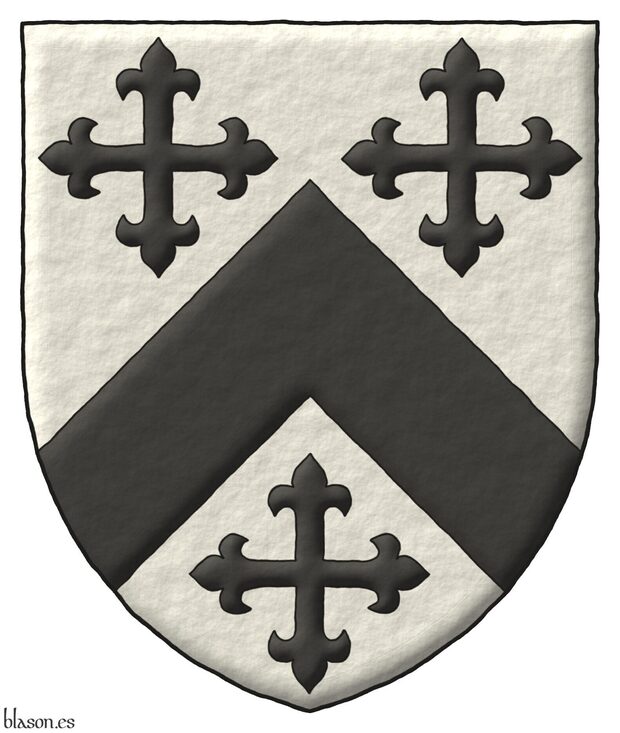
Argent, a chevron between three crosses flory Sable.
Escudo de plata, un cabrio acompañado de tres cruces flordelisadas todo de sable.
Illuminated with lights and shadows and with a freehand finish.
The coat of arms of Anderson of Erbury emblazoned by me in 4 ways: 1) tricking using abbreviations, 2) hatching using lines, 3) plain tinctures, and 4) lights and shados. It is a preliminary artwork for the arms of Nick Allen Rica II.
Blazon keywords: Without divisions, Argent, One, Chevron, Between, Three, Cross flory, Cross couped and Sable.
Style keywords: Freehand, Outlined in sable, Illuminated, Pointed, Tricking, Hatching and Plain tincture.
Classification: Interpreted, Kingdom of Scotland and Schema.
Bearer: Anderson of Erbury.


Antonio José Gómez Morillo, design process
Coats of arms emblazoned by me with a shapes ended with semi-circular arches, illuminated, and with a leather finishing.
My designs with roses and a cross patty for the coat of arms of Antonio José Gómez Morillo, the design chosen to continue working was that of the 2nd row and 3rd column.
Blazon keywords: Argent, One, Cross patty, Cross couped, Gules, Charged, Double rose, Barbed, Seeded, Between and Four.
Style keywords: Semi-circular, Outlined in sable, Illuminated and Leather.
Classification: Personal, Created and Coat of arms.
Bearer: Gómez Morillo, Antonio José.


Bernard de Tremelay
Or, a chief Gules. Behind the shield a cross patty Gules.
Blazon keywords: Or, Chief, Gules, Behind the shield, One, Cross patty and Cross couped.
Style keywords: Outlined in sable, Semi-circular, Illuminated and Freehand.
Classification: Religious, Military, Knights Templar, Interpreted and Coat of arms.
Bearer: Tremelay, Bernard de.


![Ver [Brotherhood of the Apostle Santiago, Chile in Twelve Lineages] en enlaces recomendados. Áncora de oro y la divisa enlace.](../css/Ancora.Enlace.png)
Brotherhood of the Apostle Santiago, Chile in Twelve Lineages
First publication of my heraldic artwork for this Brotherhood of the Apostle Santiago, Chile, on the blog Twelve Lineages of Soria under the following headline: Interpretation by the heraldic artist Mr. Antonio Salmerón Cabañas, of the arms of the Brotherhood of Knights of the Apostle Santiago (Chile).
Second publication of my heraldic artwork for this Brotherhood of the Apostle Santiago, Chile, on the blog Twelve Lineages of Soria with the following description of the illustration: Interpretation of the arms of the Santiago Brotherhood of Chile, by the prestigious heraldist Mr. Antonio Salmerón.
Third publication of my heraldic artwork for this Brotherhood of the Apostle Santiago, Chile, on the blog Twelve Lineages of Soria with the following description of the illustration: Coat of arms of the Brotherhood of Knights of the Apostle Santiago in Chile, versioned by the renowned heraldist Mr. Antonio Salmerón.
Fourth publication of my heraldic artwork for this Brotherhood of the Apostle Santiago, Chile, on the blog Twelve Lineages of Soria with the following description of the illustration: Brotherhood of Santiago.
Categories: Link, Republic of Chile, Freehand, Emblem, Crest and mantling, Sable, Argent, Or, Azure, Gules, Crown of Knight, Crown, Cross of Saint James, Cross couped, Party per fess, Overall (deprecated) and Mullet.
Root: Twelve Lineages of Soria.


Burgos, University of
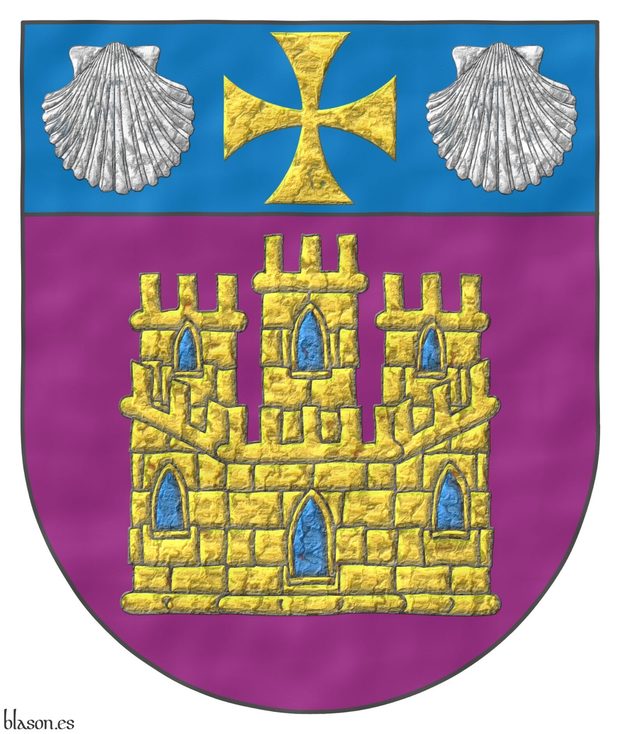
Purpure, a castle triple-towered Or, port and windows Azure, masoned Sable; on a chief Azure, a cross patty Or, between two escallops Argent.
Escudo de púrpura, un castillo de oro, aclarado de azur, mazonado de sable; un jefe de azur, cargado de una cruz patada de oro acompañada de dos veneras de plata.
Coat of arms interpreted with: a semicircular (round) base; the field and the chief watercolored in the flat tinctures Purpure and Azure; and the charges illuminated, outlined in Sable, with a very hammered metal finish.
Although it is a university of recent creation, in 1994, its best-known campus is the so-called Hospital del Rey, located on the edge of the Way of St. James and originally intended to care for pilgrims and founded, in 1195, by Alfonso VIII of Castile and Eleanor Plantagenet. The effigies of both monarchs decorate the main gate of the Hospital, called the Gate of the Pilgrims, which is, in turn, the symbol of the University of Burgos.
Regarding the escallop (venera), [Valero de Bernabé, L.; Márquez de la Plata, V. M.; 2003; page 197] notes that among the wide variety of shells, it is the scallop or pilgrim’s shell that is most used in heraldry and in blazons it is named «venera», and that it is drawn with its concave side against the field and its convex side visible, with its ribs vertical and its ears (auricles) toward the chief of the shield, and that when the concave side is shown one must specify it in the blazon as «alzada», and when the ears are in a different tincture it is said «orejada», for example, «an escallop Or, its ears Gules».
Blazon keywords: Purpure, Or, Azure, Sable, Argent, Castle, Chief, Cross, Cross patty, Cross couped and Escallop.
Style keywords: Semi-circular, Illuminated, Outlined in sable, Watercolor and Hard metal.
Classification: Interpreted, Socioeconomic and Education.
Bearer: Burgos, University of.


![Ver [Calatrava, Order of] en instituciones citadas. Fortaleza de oro y mazonada de sable.](../css/Fortaleza.Institucion.png)
Calatrava, Order of
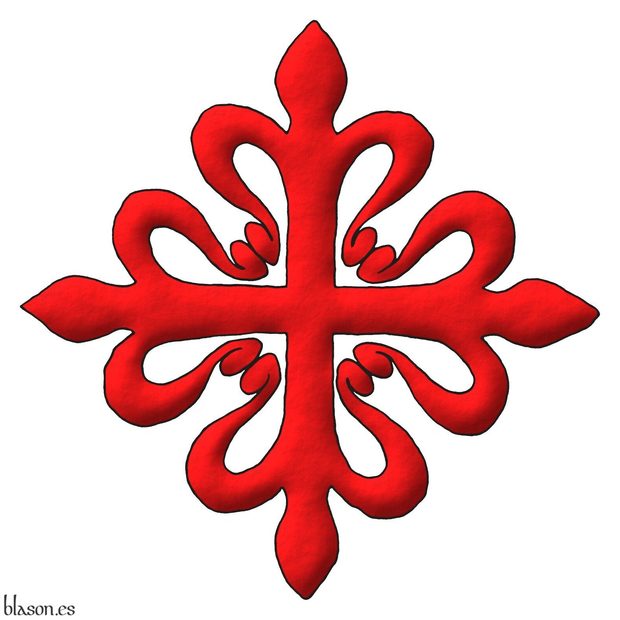
The Order of Chivalry of Calatrava is both military and religious, founded in the Kingdom of Castile during the 12th century by Abbot Raymond of Fitero.
The purpose of its foundation was the protection of the town of Calatrava la Vieja, which currently belongs to the municipality of Carrión de Calatrava in Ciudad Real. At the time of the order's foundation, it was an important city, in the middle valley of the river Guadiana and with a strategic position, as it was a necessary passage on the road from Toledo to Córdoba to Toledo and between the west and east of the Iberian Peninsula.
On the origin and antiquity of the Military Order of Calatrava, and the form of its Commandery
[Avilés, J.; 1780b; treatise IV, chapter IV, pages 334] writes «The Military Order of Calatrava was instituted by Don Sancho III, King of Castile (called the Desired), in the year 1158, while he was visiting his Kingdom; and being in Toledo with news of the great army that the Moors were gathering to besiege Calatrava la Vieja (which is called so today to distinguish it from the new one, which was founded later); and as the Templars, to whom this Fortress belonged, did not have sufficient power to resist such a large multitude, they handed it over to King Don Sancho himself so that he could take charge of it, as he did».
[Avilés, J.; 1780b; treatise IV, chapter IV, page 335] continues by telling us «The Abbot of Santa María de Fitero», near the river Pisuerga as he will indicate next, «of the Congregation of Cistercian, in the Bishopric of Palencia (which is a Monastery of St. Bernard, located on the river Pisuerga), named Don Raymond, and Friar Diego Velazquez, his subject Monk, who followed the Court, despite the difficulty of the enterprise, requested it from the King to defend it, which was granted, trusting in the virtue of the Abbot, and the strength of the Monk, who had previously been a great Knight in deeds of Arms, and very practiced in war».
[Avilés, J.; 1780b; treatise IV, chapter IV, page 336] continues «Seeing themselves in such an obligation, and that by themselves they could not fulfill it, they turned to Archbishop Don Juan (who was the fourth of Toledo) for help; and he, granting many indulgences in all his Archbishopric to those who, for themselves and for others, supplied the Place with provisions, in the same way as those who, unable to go due to old age or illness, helped with weapons, horses, and men; and having spread this news, so much help came to them, that when the Moors learned that the number of people exceeded twenty thousand men, they abandoned the conquest, returning to their homes: for this reason, the King ceded the Town of Calatrava to the Abbot of Fitero, and his successors, to defend it from the Moors from then on, confirmed later by King Alfonso IX, his son».
[Avilés, J.; 1780b; treatise IV, chapter IV, page 337] concludes «Having obtained this grace, Abbot Don Raymond brought the most suitable Monks from Fitero to Calatrava, and everything else that was necessary for living and for the defense of the Town and its land, which with the people inclined to war who remained, formed the Order of Chivalry of Calatrava, taking this name from the place where the institution was made, which in Arabic Calatrava means Castle».
Categories: Institution, Interpreted, Religious, Military, Illuminated, Outlined in sable, Freehand, Emblem, Cross of Calatrava, Cross couped and Cross.


Cavalry Regiment Alcantara, royal crown
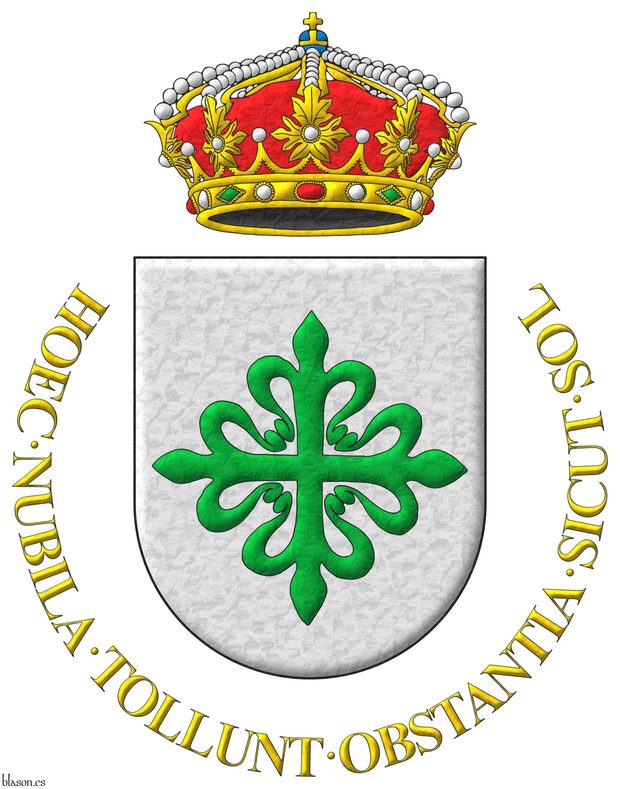
Disperse like the sun clears the clouds in your path.
Argent, a cross of Alcantara. Crest: A closed royal crown Or, with eight arches, visible five. Motto: «Hoec nubila tollunt obstantia sicut sol».
Escudo de plata, una cruz de Alcántara. Timbrado de una corona real cerrada. Lema: «Hoec nubila tollunt obstantia sicut sol».
Coat of arms interpreted in the following manner: the shape of the shield is of a semicircular arch; the field is illuminated in metal Argent; the cross of Alcantara is outlined in Sable and illuminated in Vert; the royal crown is closed, outlined in Sable and illuminated with the metal Or, Argent for the pearls, Azure and Or for the orb, Gules and Vert for the gems, Gules for the inner cloth, and Sable for the visible hollow at its base; and the whole has a slightly hammered metal finish.
Regiment's Motto
The Latin motto «Hoec nubila tollunt obstantia sicut sol» is often translated as «Ride like the sun, disperses the clouds in its path». I would like to offer the following observations on this translation:
- Instead of «disperse», I prefer the verb «scatter» which is more aligned with a cavalry regiment, [Royal Spanish Academy; 2001] «scatter, 3rd meaning, transitive verb, military term: To break up, rout the enemy, causing them to flee and scatter in complete disorder».
- On the other hand, even though it is about cavalry, I do not find that the Latin motto makes reference to riding, a verb that is also not needed to understand the motto's meaning, and adding an extra word lengthens the motto, reducing its impact.
- Finally, I use «your», instead of «its», so that the motto is a direct and personal rallying cry and not a phrase directed at a third person.
Blazon keywords: Without divisions, Argent, Cross of Alcantara, Cross couped, Cross, Crest, Closed royal crown, Crown and Motto.
Style keywords: Semi-circular, Illuminated, Outlined in sable and Soft metal.
Classification: Interpreted, Military, Army and Navy and Coat of arms.
Bearer: Alcantara, Cavalry Regiment.


Cavalry Regiment Montesa, royal crown
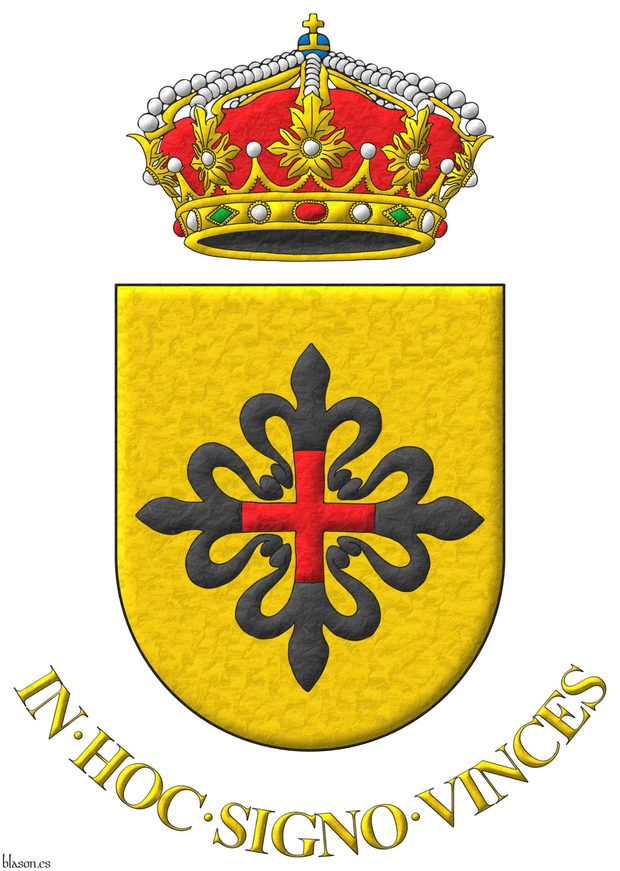
In this sign, you shall conquer.
Argent, a cross of Montesa. Crest: A closed royal crown Or, with eight arches, visible five. Motto: «In hoc signo vinces».
Escudo de oro, una cruz de Montesa. Timbrado de una corona real cerrada. Lema: «In hoc signo vinces».
Coat of arms interpreted as follows: the shape of the shield is a semi-circular arch; the field has been illuminated in metal Or; the cross of Montesa is outlined in Sable and illuminated in Sable and Gules; the royal crown is closed, outlined in Sable and illuminated the metal in Or, the pearls in Argent, the orb in Azure and Or, the gemstones in Gules and Vert, the inner cloth in Gules, and the visible hollow at its base in Sable; and the whole has a slightly beaten metal finish.
Regimental Motto
The Latin motto «In hoc signo vinces» is translated as «In this sign, you shall conquer».
Globus cruciger ~ Orb
It is called orb ~ «globus cruciger», the first in Spanish and the second in Latin, referring to the part of the royal crown, a jewel, or a jewel itself that recreates the shape of the globe topped with a cross.
Blazon keywords: Without divisions, Or, Cross of Montesa, Cross couped, Cross, Crest, Closed royal crown, Crown and Motto.
Style keywords: Semi-circular, Illuminated, Outlined in sable and Soft metal.
Classification: Interpreted, Military, Army and Navy and Coat of arms.
Bearer: Montesa, Cavalry Regiment.


Chad Michael Krouse
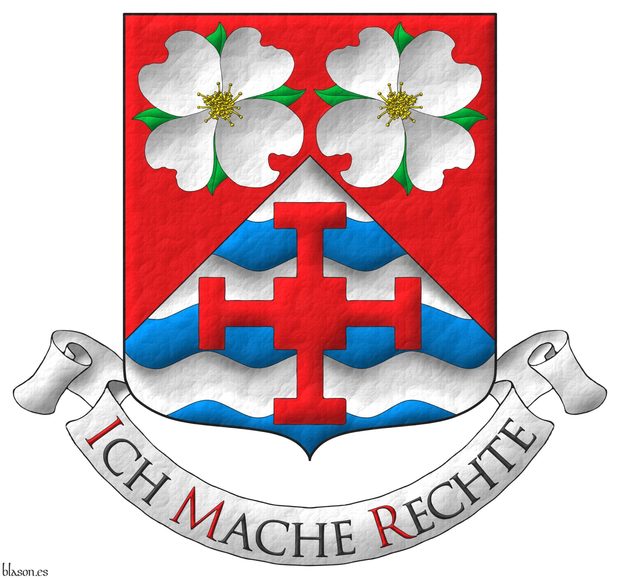
Party per chevron Gules and barry wavy Argent and Azure, in chief two Dogwood flowers (Cornus Florida) proper, in base a Cross of Saint Chad Gules. Motto: «Ich Mache Rechte».
Escudo de gules, mantelado en punta fajado ondado de plata y azur, en jefe dos flores de cornejo florido (Cornus Florida) al natural y en punta una cruz de san Chad de Mercia de gules. Lema: «Ich Mache Rechte».
Coat of arms emblazoned by me, illuminated with lights and shadows, contoured in Sable, with an ogee external shape and with a leather finish.
Blazon keywords: Gules, Argent, Azure, Two, One, Party per chevron, Barry, Wavy, In chief, Dogwood flower, Flower, Proper, In base, Cross of Saint Chad, Cross couped and Motto.
Style keywords: Outlined in sable, Illuminated, Ogee and Leather.
Classification: Personal, Interpreted, Boa and Coat of arms.
Bearer: Krouse, Chad Michael.


Crest of Austin Charles Berry
Vert, a chevron, between three cross-crosslets; on a chief Argent, three griffins statant Gules, beaked and armed Or. Crest: Upon a helm, with a wreath Argent and Gules, a griffin's head couped Gules, beaked Or. Mantling: Gules doubled Argent.
Blazon keywords: Vert, One, Chevron, Between, Three, Cross-crosslet, Cross couped, Chief, Argent, Griffin, Statant, Gules, Beaked, Armed, Or, Crest and mantling, Helm, Mantling, Wreath, Crest, Head and Party per fess.
Style keywords: Pointed, Outlined in sable, Illuminated and Freehand.
Classification: Personal, Interpreted and Coat of arms.
Bearer: Berry, Austin Charles.


Crest of Jan Bobor
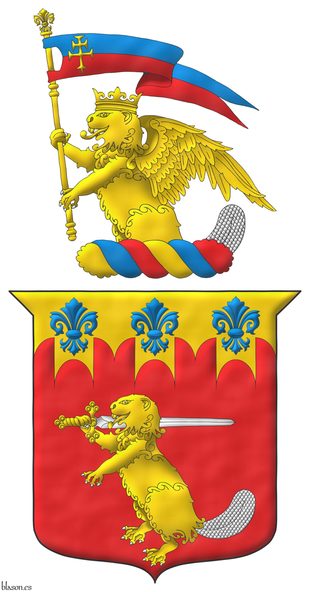
Gules, a beaver erect Or, armed and tailed Argent, bearing on his dexter shoulder a sword Argent, hilted Or; on a chief embattled of Renaissance crenellations Or three fleurs de lis Azure. Crest: Upon a wreath Or, Azure, and Gules a beaver issuant, crowned and winged Or, armed and tailed Argent, holding a pole Or flying a long swallow-tailed flag per fess Azure and Gules, overall a double cross patty fitchy Or.
Arms painted by me, highlighted with lights and shadows, contoured in Sable, with an ogee outer contour and with a watercolor finish.
Canting arms of Jan Bobor, Slovakia, emblazoned under his directions. I blazoned the beaver in the crest as «issuant», but it could also have been blazoned as a «demi-beaver». In fact, I consider «demi-beaver» more accurate, and I recommend using it rather than «issuant».
Blazon keywords: Gules, Or, Argent, Azure, One, Three, Beaver, Erect, Armed, Tailed, Grasping, Dexter, Shoulder, Sword, Hilted, Chief, Embattled, Fleur de lis, Crest, Wreath, Issuant, Crowned, Winged, Swallow-tail, Party per fess, Overall, Patriarchal cross, Cross couped, Patty and Fitchy.
Style keywords: Outlined in sable, Illuminated, Ogee and Watercolor.
Classification: Personal, Interpreted, Boa, Coat of arms, Pennon and Flag.
Bearer: Bobor, Jan.


Crest, mantling and motto of Dr. Jacques William Normand Delfin
Azure, on three bars wavy Argent, a Norman ship Or, full sail Argent; on a chief Gules, two leopards Or, armed and langued Azure; a bordure Argent charged with eight acorns bendwise Azure. Crest: Upon a helm with a wreath Or and Azure, a cross of Lorraine patty Or. Mantling: Azure doubled Or. Motto: «Marche dans ta voie avec Dieu».
Coat of arms devised by me, highlighted with lights and shadows, outlined in Sable, with an ogee outer contour and with a freehand finishing.
Coat of arms of Dr. Jacques William Normand Delfin. He is from Mexico and his family comes from Falaise in Normandy. This coat of arms has been created by him and me, and emblazoned by me.
Design rationale
The leopards symbolize the family’s origin in Falaise, Normandy, as well as the nobility of heart to help those in need; their raised claw represents the ardor in striving to accomplish the proposed undertakings; their gaze forward stands for sincerity and honesty in daily actions; their walking in pair conveys the enduring unity of the family; and the gold of their skin reflects the purity of the soul, mirrored along the path of life. The Norman drakkar sailing westward symbolizes both the family’s journey to America in search of a new horizon and the quest for knowledge in science, technology, cosmology, theology, and the Universe itself. The oak acorns represent the Breton branch of the family and embody strength, perseverance, chivalry, kindness, loyalty, sacrifice, and faith. The motto proclaims that God may be our Master, Companion, and Guide, the Light along the path, and the Shield against adversity in life’s journey. The Cross of Lorraine honors Saint Joan of Arc, who bore it upon her standard.
Blazon keywords: Azure, Argent, Or, Gules, One, Two, Eight, In base, On, Wavy, Bar, Norman ship, Full sail, Chief, Leopard, Armed, Langued, Bordure, Acorn, Bendwise, Upon (wreath), Helm, Wreath, Cross of Lorraine, Patriarchal cross, Cross couped, Patty, Mantling, Doubled and Motto.
Style keywords: Outlined in sable, Illuminated, Ogee and Freehand.
Classification: Personal, Created, Design rationale, Boa, Coat of arms and Flag.
Bearer: Normand Delfin, Jacques William.


Cross potent, cross moline, and cross of Jerusalem, comparison
A Gules and Or comparison between cross potent, cross moline, and cross of Jerusalem
Blazon keywords: Gules, Or, Cross potent, Cross couped, Cross moline, Cross of Jerusalem and Cross.
Style keywords: Freehand, Outlined in sable and Illuminated.
Classification: Schema.


Fernández Carrizo, Silvio

Quarterly: 1 Or, a lion rampant Gules; 2 Gules, a fleur de lis Or; 3 Gules, a sun of May Or; 4 Or, a cross of Bolnisi Gules.
Escudo cuartelado: 1o de oro, un león rampante de gules; 2o de gules, una flor de lis de oro; 3o de gules, un sol de mayo de oro; 4o de oro, una cruz de Bolnisi de gules.
Arms emblazoned by me, highlighted with lights and shadows, contoured in Sable, with a chasuble external shape and with a texturized finish.
Coat of arms of Silvio Fernández Carrizo emblazoned by me.
Blazon keywords: Or, Gules, One, Quarterly, Lion, Rampant, Fleur de lis, Sun of May, Cross of Bolnisi and Cross couped.
Style keywords: Outlined in sable, Illuminated and Chasuble.
Classification: Personal, Interpreted, Boa and Coat of arms.
Bearer: Fernández Carrizo, Silvio.


Full achievement of Jay Geoffrey De Graaf
Party per fess, 1 Gules, a stag rampant, issuant from base proper, in the dexter chief a Maltese cross Argent; 2 Azure, a mullet of seven points Argent. Crest: Upon a helm befitting his degree issuant from a crown of Noble above the shield, with a wreath Argent and Gules, a demi-lion Gules, crowned Or, grasping in its paws a swallow-tailed pennon lozengy Gules and Argent, shafted Sable. Mantling: Gules doubled Argent. Motto: «Per Aquas Ad Futurum». Suspended from the shield, the cross of Knight of Magistral Grace of the Sovereign Military Order of Malta.
Coat of arms painted by me, highlighted with lights and shadows, contoured in Sable, with a pointed external shape and with a freehand finish.
G0131, augmentation of G0042, Chief Herald of Arms of Malta's grant for the arms of Jay Geoffrey De Graaf, Australia. The augmentation consists of the addition of a Maltese cross Argent in the dexter chief. These arms have been emblazoned by me for such grant.
Blazon keywords: Gules, Azure, Argent, Or, One, Party per fess, Stag, Rampant, Issuant from base, Proper, In the dexter chief, Eight-pointed cross, Cross couped, Mullet, Crest, Upon (wreath), Helm, Issuant, Crown of Noble, Crown, Above the shield, Wreath, Demi, Lion, Crowned, Grasping, Paw, Swallow-tail, Lozengy, Shafted, Mantling, Motto, Suspended from the shield and Decoration.
Style keywords: Outlined in sable, Illuminated, Pointed and Freehand.
Classification: Personal, Interpreted, Boa, Coat of arms, Pennon and Flag.
Bearer: Graaf, Jay Geoffrey De.


Giovanni de Bella
Gules, a fess between, in chief a Maltese cross between two mullets of eight points Argent, in base three bendlets Or. Crest: Upon a helm issuant from a crown of Noble above the shield a with a wreath Argent and Gules, a Cirneco dell’Etna hound passant proper, gorged of a collar of meanders motifs Azure and Argent. Mantling: Gules doubled Argent. Motto: «Pete ex Animo Sapientiam».
Coat of arms emblazoned by me with a pointed shape, illuminated, and with a watercolor finishing.
G0053, Chief Herald of Malta's grant of Giovanni de Bella's arms, whose full achievement has been emblazoned by me for such grant.
Blazon keywords: Gules, One, Fess, Between, In chief, Eight-pointed cross, Cross couped, Two, Mullet, Eight, Argent, In base, Three, Bendlet, Or, Crest and mantling, Helm, Issuant, Crown of Noble, Crown, On, Mantling, Doubled, Wreath, Crest, Dog, Proper, Collared, Azure, Motto and Scroll.
Style keywords: Outlined in sable, Illuminated, Watercolor and Pointed.
Classification: Personal, Interpreted, Coat of arms, Latin language and Doctor.
Bearer: Bella, Giovanni de.


Hatching technique for the arms of the Municipality of Candasnos

Party per fess, the base per pale: 1 Or, a hurt; 2 Gules and 3 Argent, over both a cross of Malta counterchanged.
Escudo cortado y medio partido: 1o de oro, un roel de azur; 2o de gules y 3o de plata, brochante sobre ambos, una cruz de Malta del uno al otro.
Arms interpreted by me, contoured in Sable, and with a texturized finish.
Coat of arms of the municipality of Candasnos, Huesca, designed by Valeriano Labara Ballestar, approved by the Government of Aragon. It has been an honor for me to emblazon this hatching version for Valeriano Labara. [Labara Ballestar, V. C.; 2019; pages 361] «The figure of the Balsa Buena has been represented symbolically and in a stylized manner through a roundel or torteau. This avoids any hint of naturalism, which is so contrary to the art and science of heraldry».
Blazon keywords: Or, Azure, Gules, Argent, One, Party per fess, the base per pale, Hurt, Eight-pointed cross, Cross couped and Counterchanged.
Style keywords: Outlined in sable and Hatching.
Classification: Civic, Interpreted, Design rationale, Boa and Coat of arms.
Bearer: Candasnos, municipality of.


Heikki Halkosaari, plain tincture
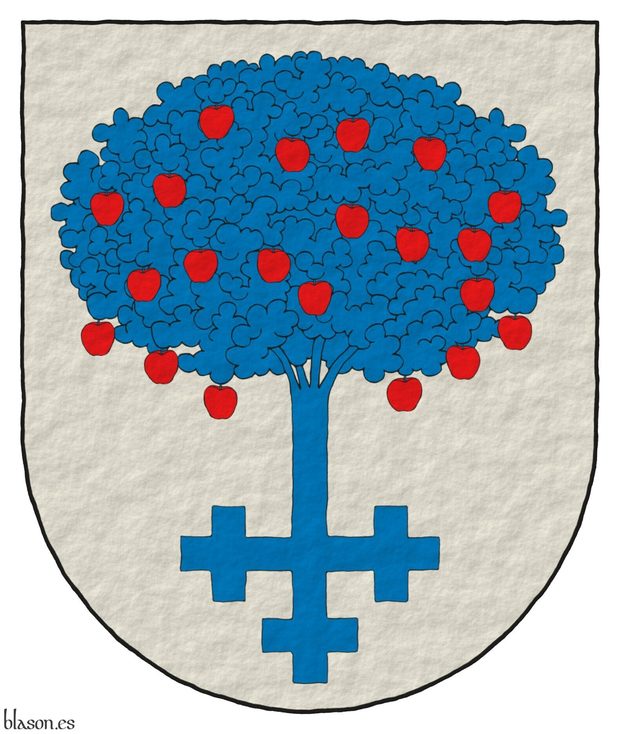
Argent, an apple tree, the base of its trunk forming a cross crosslet Azure, fructed Gules.
Arms interpreted by me, in flat tinctures, outlined in Sable, with a semi-circular outer contour and with a texturized finishing.
The coat of arms of Heikki Halkosaari, Finland, emblazoned by me.
Blazon keywords: Argent, Azure, Gules, One, Apple tree, Base, Trunk, Cross, Crosslet, Cross couped and Fructed.
Style keywords: Outlined in sable, Plain tincture and Semi-circular.
Classification: Personal, Interpreted, Boa and Coat of arms.
Bearer: Halkosaari, Heikki.


Henry of Castile, Infante
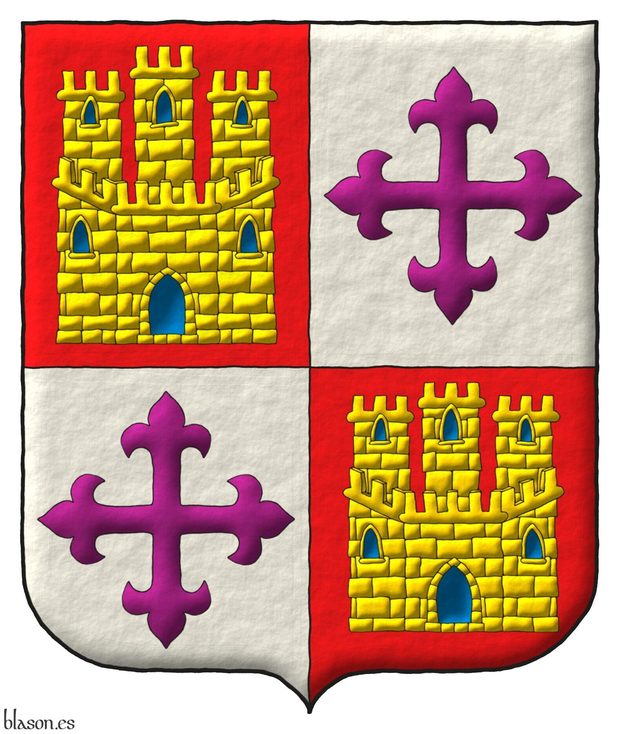
Quarterly: 1 and 4 Gules, a castle triple-towered Or, port and windows Azure, and masoned Sable; 2 and 3 Argent, a cross flory Purpure.
Escudo cuartelado: 1o y 4o de gules, un castillo de oro, aclarado de azur, mazonado de sable; 2o y 3o de plata, una cruz flordelisada de púrpura.
Arms depicted by me, highlighted with lights and shadows, outlined in Sable, with an ogee external shape and with a freehand finishing.
Coat of arms of the Infante Henry of Castile, 1230–1303, 6th offspring of the King Ferdinand III of Castile, 1199-1252, and the Queen Beatrice of Swabia, 1205–1235. He bore his father's arms, replacing the lion Purpure of the Kingdom of León with a cross flory Purpure, likely due to his close association with the Order of Calatrava, whose emblem is a cross flory Gules. However, he retained the metal Argent field in the 2nd and 3rd quarters and the lion's purple color, suggesting this was more of a conceptual change than a quartering by alliance with the Order of Calatrava.
Blazon keywords: Gules, Or, Azure, Sable, Argent, Purpure, One, Quarterly, Castle, Triple-towered, Port and windows, Masoned, Cross flory and Cross couped.
Style keywords: Outlined in sable, Illuminated, Ogee and Freehand.
Classification: Personal, Kingdom of Castile and Leon, Interpreted, Boa and Coat of arms.
Bearer: Henry of Castile, Infante.


Infante Manuel of Castile, schema 3x4
In Castile, a coat of arms quarterly does not necessarily signify inheritance. This schema illustrates two practices: a) Quarterings can represent the mother in the 1st and 4th quarters and the father in the 2nd and 3rd, highlighting the prominence given to the maternal line by placing it in the most visible quarters. b) Quarterings can also include personal symbols and concepts, like canting arms, for example, «Manuel» =«mano» + «ala» = «hand» + «wing», combined with ancestral arms. This flexibility reflects Castilian heraldic traditions, where arms are not strictly marshalled by inheritance. The inclusion of maternal arms in the 1st and 4th quarters highlights how Castilian heraldry often elevates maternal heritage, differing from some other heraldic traditions. The previous commentary emphasizes the creative freedom in Castile, where quartering could incorporate personal symbols or canting arms without the constraints of inheritance or dominium. This flexibility aligns with Castilian culture, allowing heraldry to reflect personal identity, not just dynastic ties. Notably, the arms of Infante Enrique's use of a cross flory demonstrates this creative freedom, showcasing the ability to innovate within heraldry even in royal contexts. While this might seem unconventional compared to other heraldic systems, it is deeply rooted in Castilian tradition. All coats of arms in this schema have been emblazoned by me.
Blazon keywords: Argent, Purpure, Gules, Or, Azure, Sable, One, Quarterly, Lion, Rampant, Armed, Langued, Castle, Triple-towered, Port and windows, Masoned, Bordure, Compony, Eagle, Cross flory, Cross couped, Party per pale, Hand, Arm, Vambraced, Embowed, Winged, Sword, Point upwards and Hilted.
Style keywords: Outlined in sable, Illuminated and Ogee.
Classification: Personal, Kingdom of Castile and Leon, Interpreted, Design rationale, Schema, Boa and Coat of arms.
Bearer: Manuel of Castile, Infante.


ISCH Certification for Tomasz Arkadiusz Grzeszkowiak
The Commoners' Certification of Arms for Tomasz Arkadiusz Grzeszkowiak, arms designed by Tomasz Steifer and emblazoned by me.
Gules, a base enarched Vert, overall a cross patty fitchy Or, piercing in base the head of a serpent nowed and facing sinister Sable, langued Gules. Crest: Upon a helm affronty, with a wreath Sable and Gules, in a front of three ostrich feathers alternately Sable and Gules a paschal lamb Argent, haloed Or and Gules, supporting a staff Or, flying a banner Argent charged with a cross Gules. Mantling: Gules doubled Sable. Motto: «Amor vincit omnia»
In the blazon of this certification, I wrote the expression «a Base enarched Vert», it is correct. But the expression «a Mount Vert» it is also possible. In the original expression in the Polish blazon is «na zielonym wzgórkuon» ~ «the green hill».
Blazon keywords: Without divisions, Gules, One, Mount, Vert, Issuant from base, Overall, Cross patty fitchy, Cross couped, Piercing, Head, Serpent, Nowed, Facing sinister, Sable, Langued, Helm, Affronty, Two, Mantling, Doubled, Wreath, Three, Quill, Alternately, Debruised, Paschal lamb, Argent, Nimbed, Or, Grasping, Shafted, Charged, Cross and Motto.
Classification: Interpreted, Personal, Certification, Heraldic document and Flag.
Bearer: Grzeszkowiak, Tomasz Arkadiusz.


Jacques de Molay
Azure, a bend Or. Behind the shield an eight-pointed cross patty Gules.
Blazon keywords: Azure, One, Bend, Or, Behind the shield, Eight-pointed cross, Cross couped and Gules.
Style keywords: Outlined in sable, Illuminated, Semi-circular and Freehand.
Classification: Religious, Military, Knights Templar, Interpreted and Coat of arms.
Bearer: Molay, Jacques de.


Jamilena, province of Jaen
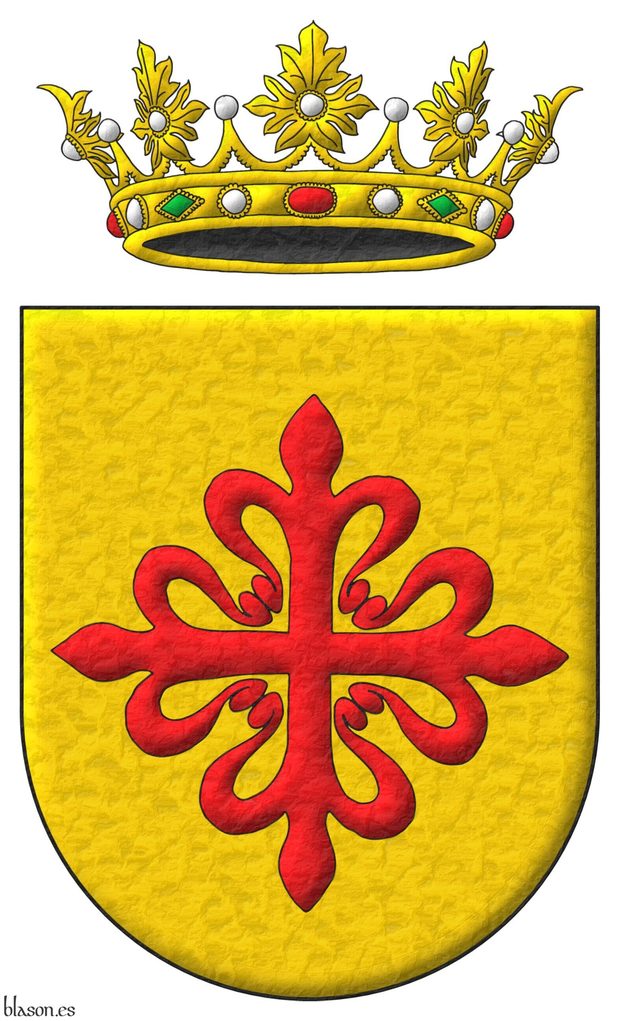
Or, a cross of Calatrava. Crest: An open royal crown Or.
Escudo de oro, una cruz de Calatrava. Timbrado de una corona real abierta.
Coat of arms interpreted as follows: the shield's shape is a semicircular arch; the field is illuminated in metal Or; the cross of Calatrava is outlined in Sable and illuminated in Gules; the royal crown is open, outlined in Sable and illuminated in metal Or, pearls in Argent, gemstones in Gules and Vert, and the visible base hollow in Sable; and the entire piece has a slightly hammered metal finish.
The municipality of Jamilena belongs to the La Campiña region and is the smallest in the province of Jaén. I have depicted its coat of arms with an open royal crown, but representations with a closed royal crown can also be found.
The origin of the cross of Calatrava in its heraldic coat of arms dates back to the year 1525 when Emperor Charles V issued several decrees from Toledo to build a convent for nuns in Jamilena. For the construction of this convent, stones from the Muslim castle, which was reformed and occupied by the Order of Calatrava, were used.
Blazon keywords: Without divisions, Or, Cross of Calatrava, Cross couped, Cross, Crest, Open royal crown and Crown.
Style keywords: Semi-circular, Illuminated, Outlined in sable and Soft metal.
Classification: Interpreted, Civic and Coat of arms.
Bearer: Jamilena.


Kane, Kathleen
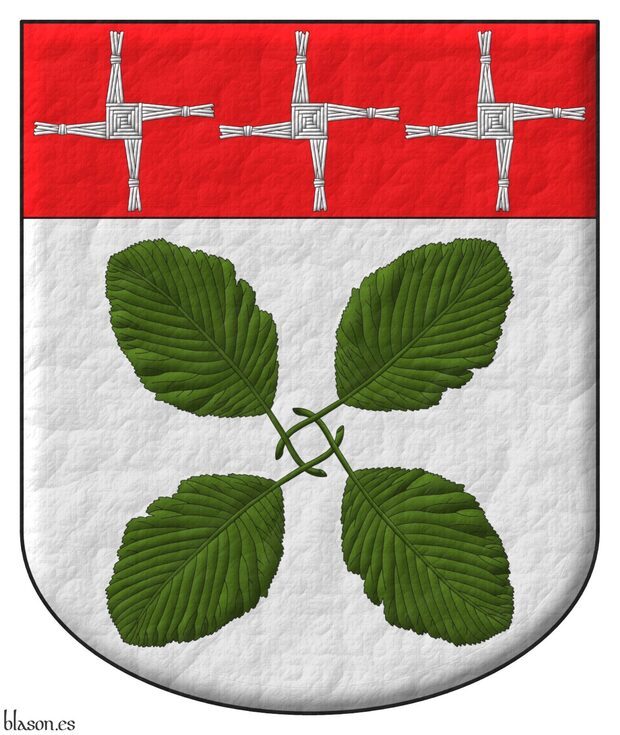
Argent, four leaves of silver-leaved whitebeam (Sorbus Aria Lutescens) in saltire, stems interlaced Vert, on a chief Gules, three crosses of Saint Brigid Argent.
Coat of arms emblazoned by me with a rounded shape, illuminated, and with a leather finishing.
Blazon keywords: Argent, Four, Leaf, In saltire, Stem, Interlaced, Vert, Chief, Gules, Three, Cross of Saint Brigid and Cross couped.
Style keywords: Outlined in sable, Rounded, Illuminated and Leather.
Classification: Personal, Interpreted and Coat of arms.
Bearer: Kane, Kathleen.


King Arthur, cross flory
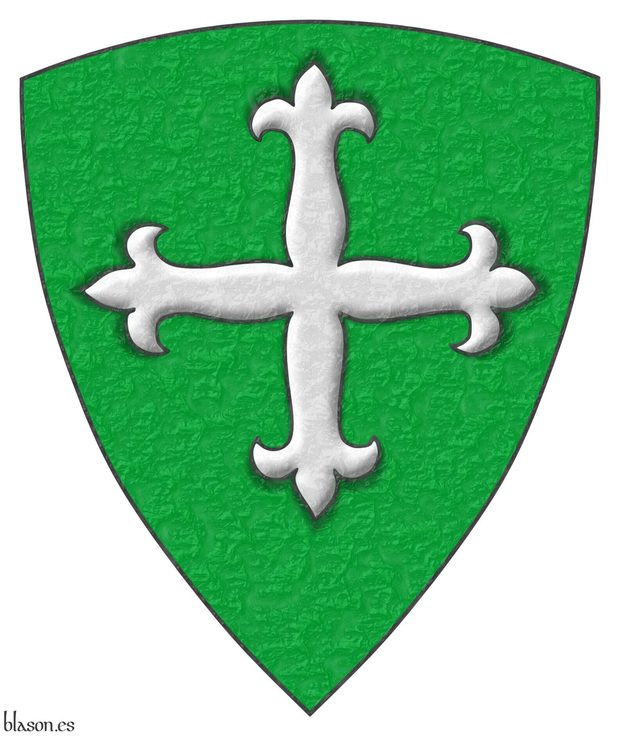
Arthur Pendragon
Sinople, a cross flory Argent.
Escudo de sinople, una cruz flordelisada de plata.
Imaginary coat of arms interpreted as follows: the mouth of the shield is triangular and curved; the field has been enameled with flat color Vert; the cross flory is illuminated Argent and shaded; and the finish is crystalline.
Its interpretation has been based on the banner that can be consulted in [Edward IV of England; 1461; row 15, 1st column]. Note that King Arthur is represented in this armorial by 2 different arms.
Blazon keywords: Without divisions, Vert, Argent, Cross flory and Cross couped.
Style keywords: Illuminated, Shaded, Outlined in sable, Crystalline and Triangular curved.
Classification: Interpreted, Imaginary, Coat of arms and Kingdom of England.
Imaginary bearer: Arthur of Britain.


Kingdom of Jerusalem
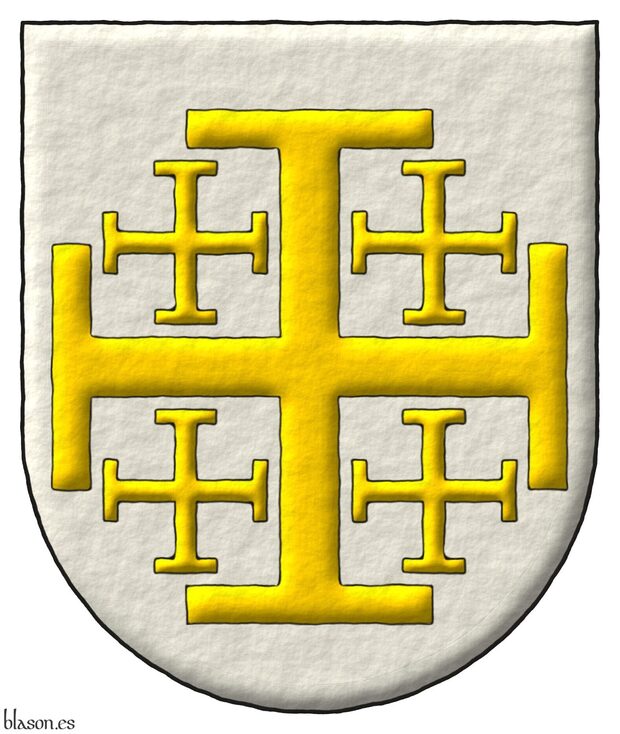
Metal Or over metal Argent.
Argent, a cross potent cantoned of four crosslets potent Or.
Escudo de plata, una cruz potenzada cantonada de cuatro cruces potenzadas todas de oro.
Illuminated with lights and shadows and with a freehand finish.
Perhaps the most classic example of non-compliance with the heraldic rule of tinctures having metal Or over metal Argent. In [Galdiano L.; Century XVII; folio 6], you can see a version of the arms of Jerusalem with the field in Gules, which would indeed follow the rule of tinctures as it is metal on color.
Blazon keywords: Without divisions, Argent, One, Cross potent, Cross couped, Cantoned, Four and Or.
Style keywords: Freehand, Outlined in sable, Illuminated, Semi-circular and Metal on metal.
Classification: Interpreted and Civic.
Bearer: Kingdom of Jerusalem.


![Ver [Montesa, Order of] en instituciones citadas. Fortaleza de oro y mazonada de sable.](../css/Fortaleza.Institucion.png)
Montesa, Order of
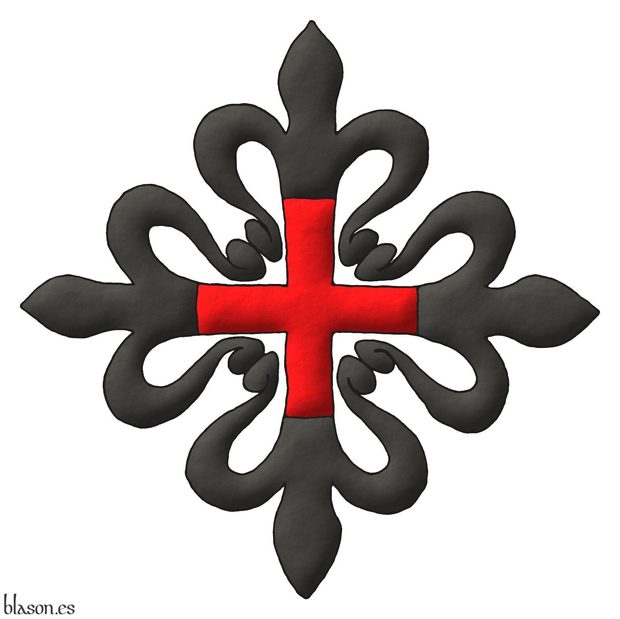
The Order of Saint Mary of Montesa and Saint George of Alfama, known as the Order of Montesa, was founded in the 14th century by the King of Aragon, James, as a military and religious order, to which he donated a castle in Valencia from which they took their name.
To endow the new Order of Montesa, the assets of the Order of the Templars, dissolved by Pope Clement V, were used. This is recounted by [Avilés, J.; 1780b; page 342] writing that Montesa was created «from the incomes and ruin of the Templars; as their Order was being extinguished, at the request of the Kings, so that said incomes would not leave the Kingdom.».
The order established within the Castle of Montesa, which previously belonged to the Templars, their convent and church of the Order, the palace of their Master, their barracks for fighting men, being able to form up to a couple of thousand of them in their parade ground. Their first Master, for 70 days since he died just over two months after his appointment, was Guillermo de Eril.
The origin and antiquity of the Military Order of Montesa, and the form of its Encomienda.
[Avilés, J.; 1780b; treatise IV, chapter VI, page 341] describes it as follows «The Military Order of Montesa was instituted in the year 1317 by the King of Aragon, Don Jaime II, and confirmed in the same year by Pope John XXII.».
Categories: Institution, Interpreted, Religious, Military, Illuminated, Outlined in sable, Freehand, Emblem, Cross of Montesa, Cross couped and Cross.


Nilda Ernestina Lucca de Anaya, The Armorial Register
Registered by The International Register of Arms, 6th of June of 2020, Registration number 0559, Volume 4.
Categories: Armorial roll, Azure, Chevron, Between, In chief, Cross of Jerusalem, Cross couped, Cross potent, Cantoned, Crosslet, Lion, Rampant, In base, Celtic Trinity knot, Knot, Celtic, Trinity and Scroll.
External link:
Root: The Armorial Register.


Noblemen of Navarre
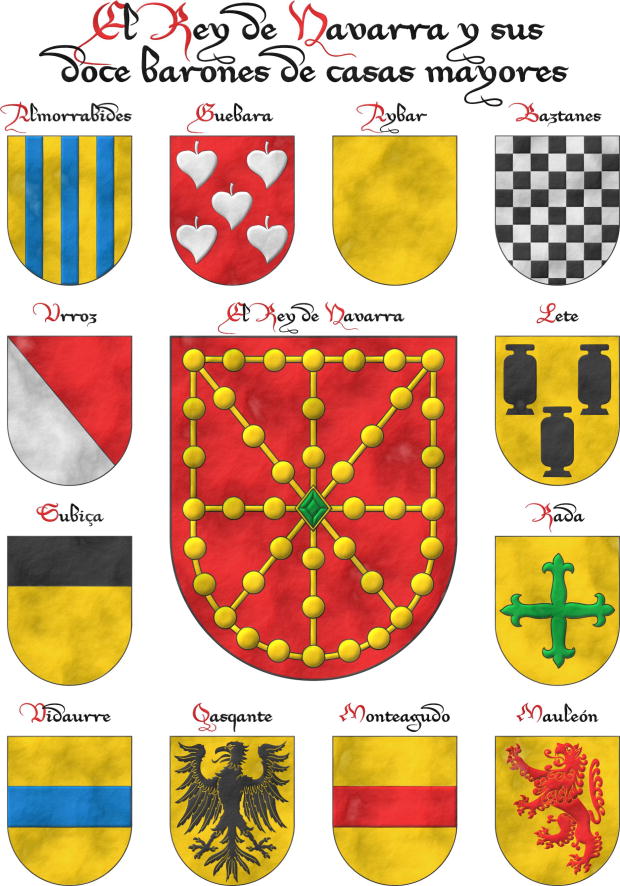
The King of Navarre, at the time of his new and solemn coronation, is raised and lifted up as King by the hands of twelve barons of the greatest and oldest houses of the said Kingdom, and these are the twelve Noblemen who are named on the other side, with their blazons and coats of arms.
Interpretation and composition of 13 coats of arms that I have created with a parchment-like finish.
A free interpretation, for example, without the central crown over the arms of Navarre, with a different title, written «Navarra» and not «Nabarra», etc., based on the principal plate of [Bosque, J. del; 1540; folio 1 of the numbering of 1613] and with texts taken from the transcription by [Martinena Ruiz, J. J.; 1982; pages 122 and 123].
«Ricohombre», written together, currently means «title that formerly belonged to the highest nobility of Spain», [Real Academia Española; 2001].
Its plural «ricoshombres» is the most commonly used form, but «ricohombres» is also correct and used; and in [Bosque, J. del; 1540] it is written separately, and «honbre» with an «n» before the «b», that is, «ricos honbres».
Blazon keywords: Without divisions, Party per bend, Azure, Gules, Or, Argent, Sable, Vert, Eagle, Chequey, Cross flory, Cross couped, Fess, Chief, Lion, Pale, Poplar leaf, Clay pot and Rampant.
Style keywords: Semi-circular and Old parchment.
Classification: Interpreted and Kingdom of Navarre.
Bearer: Noblemen of Navarre.


o-XI, heraldic document
Heraldic document, 2 pages.
The pages have a heraldic frame with the elements of his coat of arms.
The motto, which is the beginning of the Gospel of Saint John, can be seen in [Cnut Gospels; 1020; folio 111].
Blazon keywords: Quarterly, Sable, Or, One, Letter, Two, Wolf, Passant, In pale, Number, Gules, Argent, Azure, Crest and mantling, Helm, Mantling, Wreath, Crest, On, Charged, Disordered, Cross, Cross of Burgundy, Cross couped, Book, Open, Motto, Scroll and Fimbriated.
Classification: Created, Personal, Catalogue, Heraldic document and Frame.
Bearer: Salmerón Cabañas, Antonio.


Order of Mercy, pointed and rounded
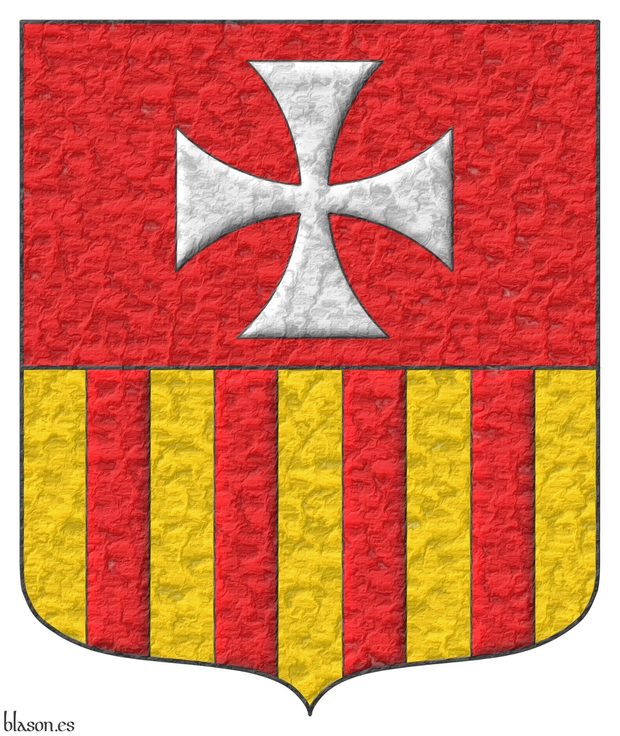
Order founded in 1218 by Saint Peter Nolasco.
Party per fess: 1 Gules, a cross patty Argent; 2 Or, four pallets Gules.
Escudo cortado: 1o de gules, una cruz patada de plata; 2o de oro, cuatro palos de gules.
Already existing arms interpreted by me in the following way: the mouth of the coat of arms is pointed and rounded; its field has been enameled with Gules and Or flat tinctures; the cross patty and the 4 pales are illuminated; and the whole coat of arms has a hammered metal finish.
Blazon keywords: Party per fess, Gules, Or, Argent, Cross, One, Cross patty, Cross couped and Pale.
Style keywords: Ogee, Illuminated, Outlined in sable and Metal beaten.
Classification: Interpreted, Religious and Coat of arms.
Bearer: Our Lady of Mercy, Order of.


Province of Cáceres, structured blazons in parallel
Blazon keywords: Argent, Purpure, Gules, Or, Azure, Party per pale, Castle, Lion, Port and windows, Masoned, Rampant, Armed, Langued, Crowned, Crest and mantling, Crown, Open royal crown, Behind the shield, Cross, Cross of Alcantara and Cross couped.
Style keywords: Semi-circular, Illuminated and Watercolor.
Classification: Interpreted, Civic, Coat of arms and Structured and parallel blazons.
Bearer: Cáceres, Province of.


Quartered arms of André de Montbard
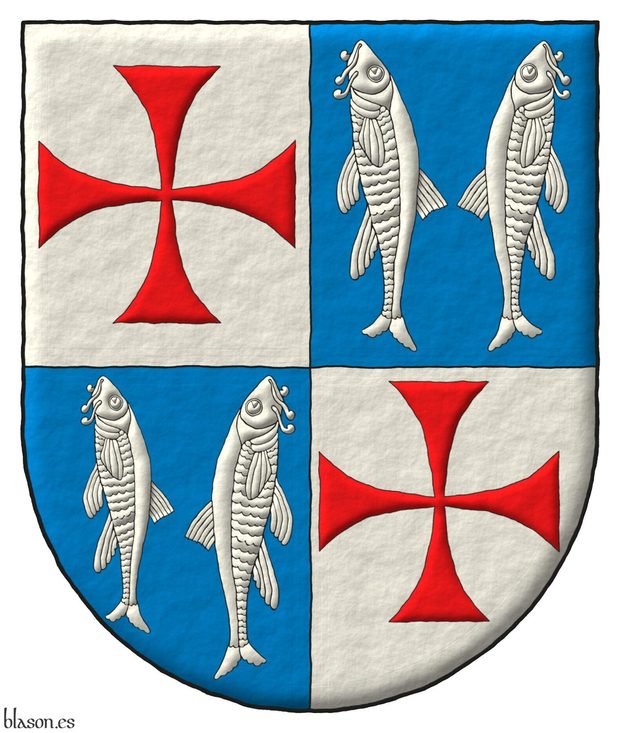
Quarterly: 1 and 4 Argent, a cross patty Gules; 2 and 3 Azure, two barbels addorsed Argent
Escudo cuartelado: 1o y 4o de plata, una cruz patada de gules; 2o y 3o de de azur, dos barbos adosados de plata.
Blazon keywords: Azure, Two, Barbel, Addorsed, Argent, Quarterly, One, Cross patty, Cross couped and Gules.
Style keywords: Outlined in sable, Semi-circular, Illuminated and Freehand.
Classification: Religious, Military, Knights Templar, Interpreted and Coat of arms.
Bearer: Montbard, André de.


Quartered arms of Bertrand de Blanchefort
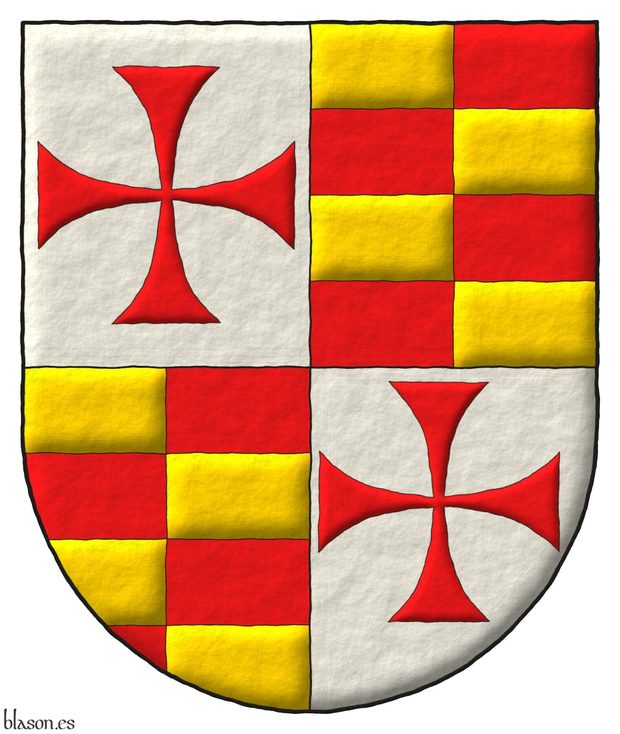
Quarterly: 1 and 4 Argent, a cross patty Gules; 2 and 3 Barry of four per pale counterchanged Or and Gules.
Escudo cuartelado: 1o y 4o de plata, una cruz patada de gules; 2o y 3o de contrafajado de cuatro piezas de oro y gules.
Blazon keywords: Barry per pale counterchanged, Four, Or, Gules, Quarterly, Argent, One, Cross patty and Cross couped.
Style keywords: Outlined in sable, Semi-circular, Illuminated and Freehand.
Classification: Religious, Military, Knights Templar, Interpreted and Coat of arms.
Bearer: Blanchefort, Bertrand de.


Quartered arms of Gilbert Hérail
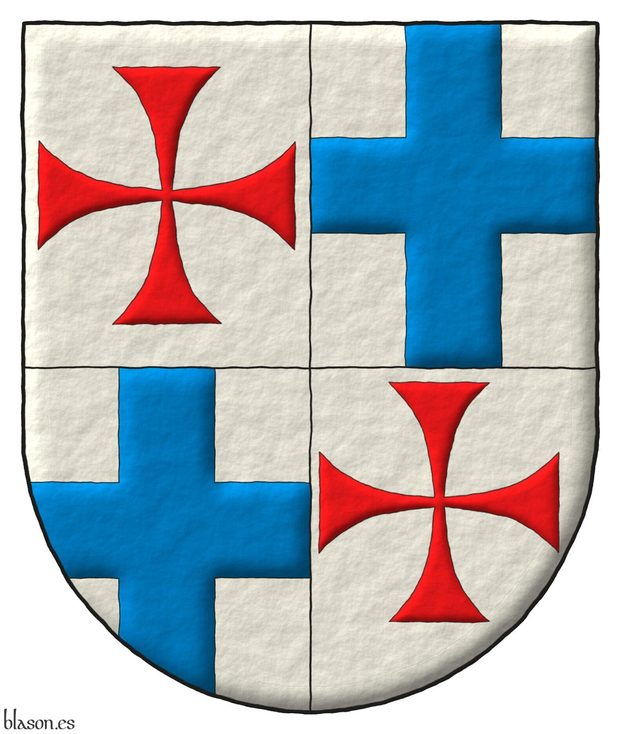
Quarterly: 1 and 4 Argent, a cross patty Gules; 2 and 3 Argent, a cross Azure
Escudo cuartelado: 1o y 4o de plata, una cruz patada de gules; 2o y 3o de plata, una cruz de azur.
Blazon keywords: Argent, One, Cross, Azure, Quarterly, Cross patty, Cross couped and Gules.
Style keywords: Outlined in sable, Illuminated, Semi-circular and Freehand.
Classification: Religious, Military, Knights Templar, Interpreted and Coat of arms.
Bearer: Hérail, Gilbert.


Quartered arms of Richard de Bures
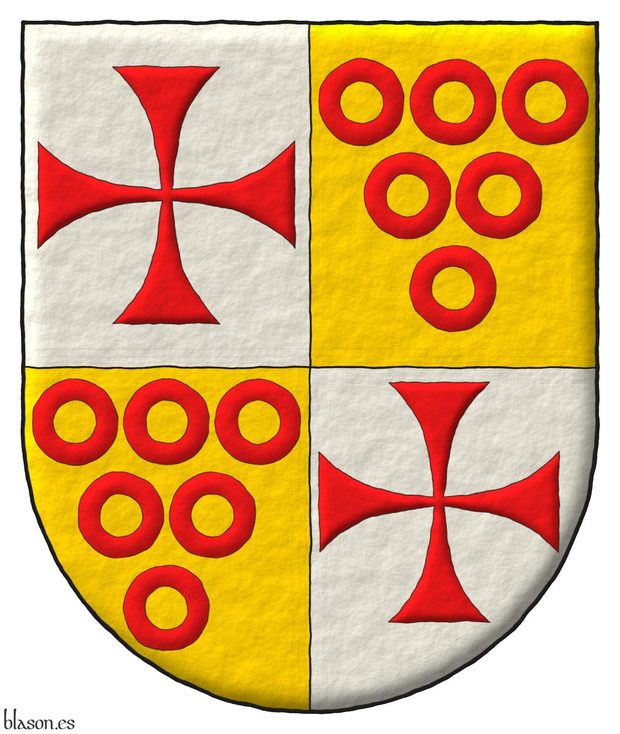
Quarterly: 1 and 4 Argent, a cross patty Gules; 2 and 3 Or, six annulets Gules, 3, 2, and 1.
Escudo cuartelado: 1o y 4o de plata, una cruz patada de gules; 2o y 3o de de oro, seis anilletes de gules, ordenados 3, 2 y 1.
Blazon keywords: Or, Six, Annulet, Gules, Ordered, Three, Two, One, Quarterly, Argent, Cross patty and Cross couped.
Style keywords: Outlined in sable, Semi-circular, Illuminated and Freehand.
Classification: Religious, Military, Knights Templar, Interpreted and Coat of arms.
Bearer: Richard, Richard.


Rada of Navarre
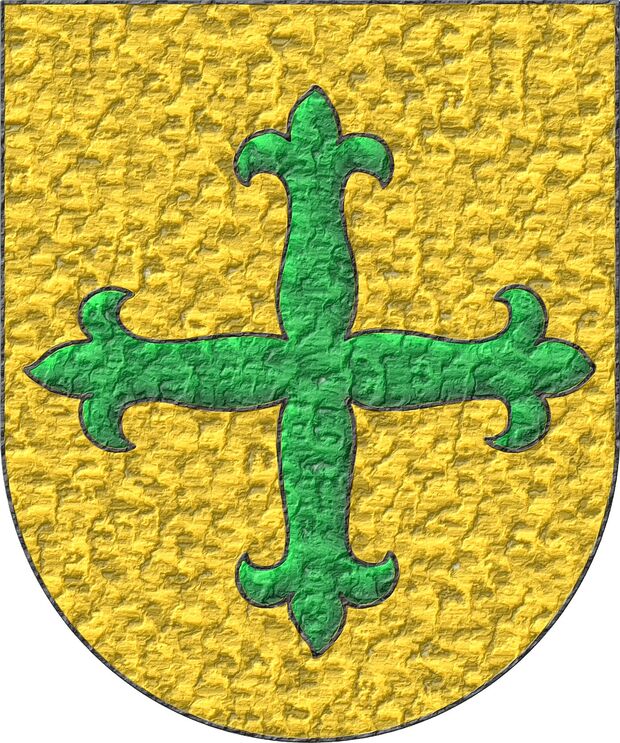
Of the twelve lineages of Noblemen, the eighth is that of Rada; they bear as arms a shield Or with a flory cross Vert, in the same manner as painted in this shield.
Or, a Cross flory Sinople.
Escudo de oro, una cruz flordelisada de sinople.
Coat of arms interpreted with: a semicircular (round) base; the field in flat Or; the flory cross outlined in Sable and illuminated in Vert enamel; and finished in highly-hammered metal.
Based on the eighth coat of arms of the Navarrese «ricoshombres» from [Bosque, J. del; 1540; folio 1 of the numbering of 1613] and the text is from the transcription made by [Martinena Ruiz, J. J.; 1982; pages 122 and 123].
Under the title «Surname of Rada» it can also be consulted in [Vega, P. J. de; 1702; folio 8 of the manuscript].
Blazon keywords: Without divisions, Or, Cross flory, Cross couped and Vert.
Style keywords: Semi-circular, Illuminated, Outlined in sable and Hard metal.
Classification: Interpreted, Personal and Kingdom of Navarre.
Bearer: Rada of Navarre.


Renaud de Vichiers
Vair. Behind the shield an eight-pointed cross patty Gules.
Blazon keywords: Vair, Behind the shield, One, Eight-pointed cross, Cross couped and Gules.
Style keywords: Outlined in sable, Illuminated, Semi-circular and Freehand.
Classification: Religious, Military, Knights Templar, Interpreted and Coat of arms.
Bearer: Vichiers, Renaud de.


Reverend Nilda Ernestina Lucca de Anaya
Azure, a chevron Or, between in chief a cross potent cantoned of crosslets, and a lion rampant, and in base a Celtic Trinity knot Argent. Crest: A galero Sable, with two cords, each with one tassel Gules and Sable.
Credits:
- Ernesto Juan Anaya is the designer of the coat of arms.
- Antonio Salmerón y Cabañas is the author of the heraldic art.
Blazon keywords: Azure, One, Chevron, Or, Between, In chief, Cross of Jerusalem, Cross couped, Cross potent, Cantoned, Four, Crosslet, Lion, Rampant, In base, Celtic Trinity knot, Knot, Celtic, Trinity, Crest and mantling, Galero, Cord and Tassel.
Style keywords: Outlined in sable, Illuminated, Pointed and Freehand.
Classification: Religious, Interpreted and Coat of arms.
Bearer: Lucca de Anaya, Nilda Ernestina.


Robert de Craon
Lozengy Or and Gules. Behind the shield a cross patty Gules.
Blazon keywords: Lozengy, Or, Gules, Behind the shield, One, Cross patty and Cross couped.
Style keywords: Outlined in sable, Illuminated, Semi-circular and Freehand.
Classification: Religious, Military, Knights Templar, Interpreted and Coat of arms.
Bearer: Craon, Robert de.


Royal Council of the Orders of Chivalry, emblem
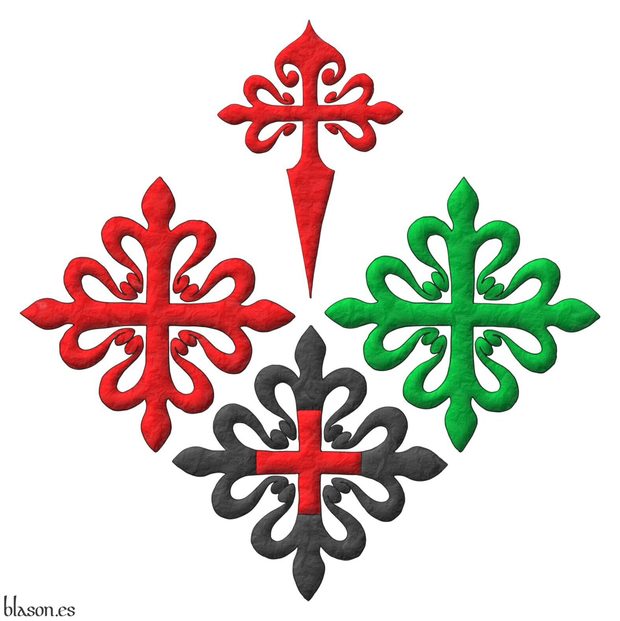
Royal Council of the Orders of Chivalry, of Santiago, Calatrava, Alcantara, and Montesa.
Emblem quarterly per saltire: 1, a cross of Saint James; 2, a cross of Calatrava; 3, a cross of Alcantara; 4, a cross of Montesa.
Emblema cuartelado en sotuer: 1o, una cruz de Santiago; 2o, una cruz de Calatrava; 3o, una cruz de Alcántara; 4o, una cruz de Montesa.
Interpretation of the emblem of the Royal Council with: its four crosses outlined in Sable, illuminated in Gules, Vert, and Sable; and a heavily hammered metal finish.
There is another version of this emblem of the Royal Council with the crosses of its four orders of Santiago, Calatrava, Alcantara, and Montesa outlined in Or instead of Sable.
Blazon keywords: Cross, Quarterly per saltire, Cross of Saint James, Cross couped, Cross of Calatrava, Cross of Alcantara and Cross of Montesa.
Style keywords: Illuminated, Outlined in sable and Freehand.
Classification: Interpreted, Socioeconomic and Emblem.
Bearer: Royal Council of the Orders of Chivalry.


![Ver [Santiago, Order of] en instituciones citadas. Fortaleza de oro y mazonada de sable.](../css/Fortaleza.Institucion.png)
Santiago, Order of
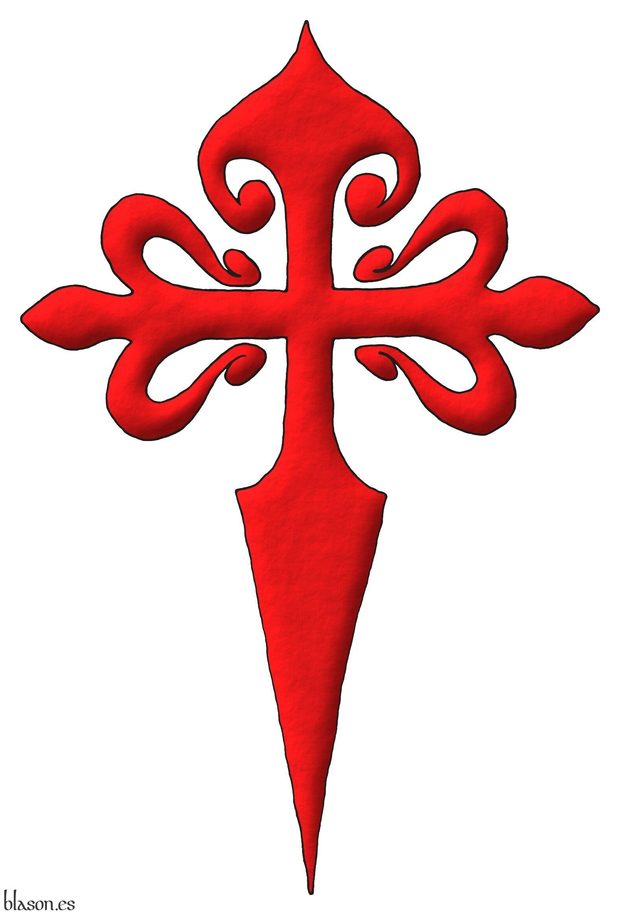
The Order of Chivalry of Santiago is both military and religious. It was founded in the Kingdom of León during the 12th century, although there is a difference of opinion regarding its exact year of foundation. It is named after the patron saint of Spain, James the Greater.
The purpose of its foundation was the protection of the Way of Saint James and the pilgrims who traveled it, and to participate militarily in the advancement of the reconquest of the Iberian Peninsula.
Of the Military Order of Santiago of the Sword, of its origin, and antiquity, as well as the form of its Commandery
[Avilés, J.; 1780b; treatise IV, chapter II, page 325] writes «The oldest authentic instrument that is found regarding the origin of the Order of Chivalry of Santiago of the Sword», observe how José de Avilés e Iturbide refers to the order in the masculine form, «is the donation made in the years of 848», note how the Marquess of Avilés does not doubt the antiquity of this order and even in other subsequent paragraphs, he dates it even earlier than currently believed, «made to the Church of Santiago by the King of León Don Ramiro in memory of the famous victory he achieved against the Moors in the battle of Clavijo (two leagues from Logroño), as evidenced by its Privilege, for having seen this Holy Apostle armed and mounted on a Horse, fighting in defense of the Christians; to whose devotion, and in this recognition, the said Order was instituted, taking from it its origin and name, as well as the same Cross that the Saint bore on his chest, and Shield, represented in the form of a Sword, of red color», gules ~ red, «for the blood shed of the Infidels, of whom Don Rodrigo Ximenez, Archbishop of Toledo, in his Chronicle Book VII says»: «Kubet ensis sanguine Arabum».
Drawing with a single stroke
Cross of Saint James the Greater drawing by me with a single stroke. This is the reason why it is asymmetrical, it has the base tip crooked, there are some sides higher than others, and it shows the failure of my pulse in a certains turns.
It is by far my most downloaded and copied painting, the most used on websites, citing me or not, the most used in hotels advertising, parish sheets... and even on T-shirts.
Categories: Institution, Interpreted, Religious, Military, Illuminated, Outlined in sable, Freehand, Emblem, Cross of Saint James, Cross couped and Cross.


Sean Shriner
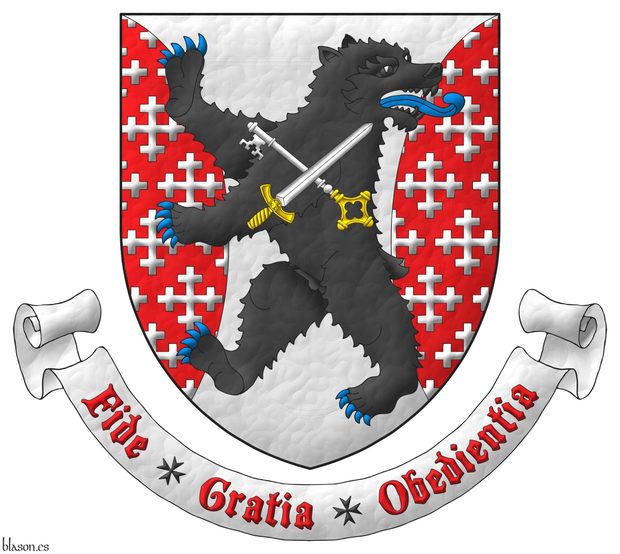
Argent, flanched Gules crusilly of cross-crosslets Argent, overall a bear rampant regardant Sable, armed and langued Azure, charged with a key and a sword in saltire Argent, hilted Or, the key debruised by the sword. Motto: «Fide Gratia Obedientia» Gules over a scroll Argent.
Escudo de plata, flanqueado curvo de gules sembrado de cruces recrucetadas de plata, brochante sobre el todo un oso rampante y contornado de sable, armado y lampasado de azur, cargado de una llave y una espada en sotuer de plata, ambas guarnecidas de oro y la llave resaltada de la espada. Lema: «Fide Gratia Obedientia» de gules sobre una filacteria de plata.
Coat of arms painted by me, highlighted with lights and shadows, contoured in Sable, with a pointed external shape and with a leather finishing.
Coat of arms of Sean Shriner, designed by The Armorial Register, and revised and emblazoned by me.
Blazon keywords: Argent, Gules, Sable, Azure, Or, One, Flanched, Semé, Cross-crosslet, Cross couped, Overall, Bear, Rampant, Regardant, Armed, Langued, Charged, Key, Sword, In saltire, Hilted, Debruised, Motto and Scroll.
Style keywords: Outlined in sable, Illuminated, Pointed and Leather.
Classification: Personal, Interpreted, Boa and Coat of arms.
Bearer: Shriner, Sean.


Shield surrounded by the Grand Collar of the OERC
It has been interpreted by me, highlighted with lights and shadows, outlined in Sable, with a semi-circular outer contour and with a rough finishing.
Coat of arms with the Grand collar of the Ordo Equestris Reginae Caeli emblazoned by me. The OERC promotes solidarity, compassion, and the spirit of service toward those most in need.
Blazon keywords: Order, Decoration, Azure, Or, Argent, One, Four, Eight-pointed cross, Cross couped, Fleur de lis, Crowned, Monogram, Grand collar and Surrounded.
Style keywords: Outlined in sable, Illuminated, Semi-circular and Rough.
Classification: Interpreted and Boa.
Bearer: Ordo Equestris Reginae Caeli.


Sister Esperanza Vega Lanzagorta, plain tincture
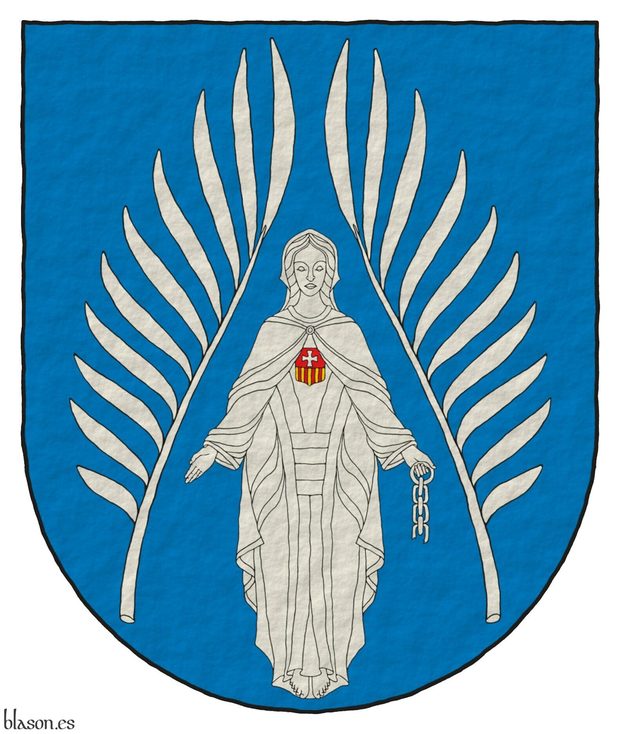
Azure, between two palm fronds in pile reversed a Lady of Mercy grasping in her sinister hand a broken chain Argent, and charged on the chest with an escutcheon per fess, 1 Gules, a cross patty Argent, and 2 Or, four pallets Gules.
Coat of arms designed by me, in flat tinctures, outlined in Sable, with a semi-circular external shape and with a texturized finishing.
This is the coat of arms of Sister Esperanza Vega Lanzagorta, designed by Juan Lanzagorta Vallin and painted by me. Alternative blazon: «Azure, between two palm fronds in pile reversed a Virgin of Mercy grasping in her sinister hand a broken chain Argent, and charged on the chest the Mercedarian coat of arms».
Credits: Juan Lanzagorta Vallin is the designer of the coat of arms.
Blazon keywords: Azure, Argent, Gules, Or, One, Two, Our Lady of Mercy, Grasping, Sinister, Hand, Broken, Chain, Charged, Chest, Escutcheon, Party per fess, Cross patty, Cross couped, Between, Palm frond and In pile reversed.
Style keywords: Outlined in sable, Plain tincture and Semi-circular.
Classification: Personal, Created, Boa and Coat of arms.
Bearer: Vega Lanzagorta, Sister Esperanza.


Standard of Laurent Liu-Lecomble
Heraldic device designed by me, illuminated with lights and shadows, outlined in Sable, and with a leather finish.
This is the heraldic standard of Laurent Liu-Lecomble, designed by him and me, and emblazoned by me. Structure: coat of arms; from his badge, the two arms bendwise proper, grasping a sword bend sinisterwise; motto «Semper renascitur»; a leopard Or, armed and langued Azure; warcry «Mon dû»; from his badge, the two arms bendwise grasping a sword bend sinisterwise.
Blazon keywords: Azure, Argent, Gules, Or, One, Two, Three, Quarterly, Dexter, Hand, Appaumée, Sword, Point upwards, Between, Cross patty, Cross couped, Sinister, Eight-pointed cross, Plough share, Affronty, Disordered, Eagle claw, Inescutcheon, Charged, Fleur de lis, Arm, Bendwise, Proper, Grasping, Bend sinisterwise, Motto, Leopard, Passant, Armed, Langued and War cry.
Style keywords: Outlined in sable, Illuminated and Leather.
Classification: Personal, Created, Boa, Standard and Flag.
Bearer: Liu-Lecomble, Laurent.


Tercio Alessandro Farnese, plain tincture
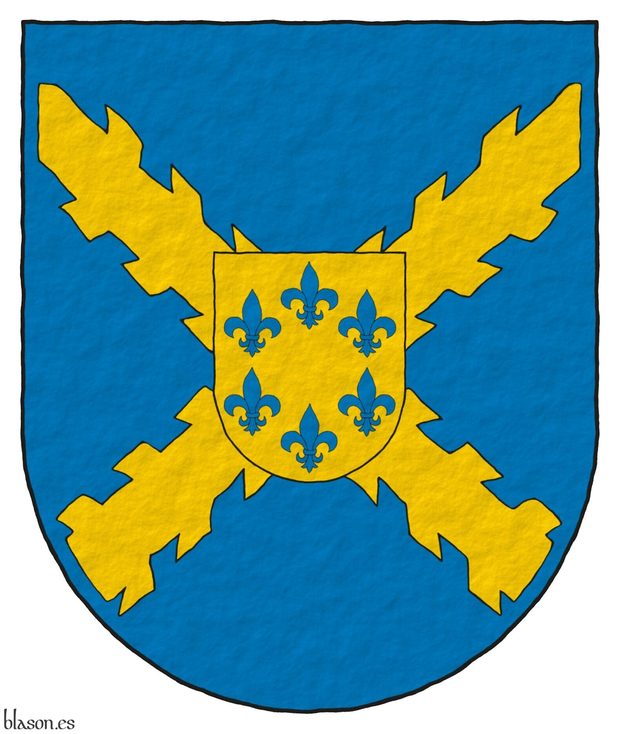
Azure, a cross of Burgundy Or; an inescutcheon Or, six fleurs de lis in orle Azure.
Coat of arms depicted by me, in plain tinctures, outlined in Sable, with a semi-circular external shape and with a texturized finishing.
Coat of arms of the Tercio Alessandro Farnese, 4th of the Spanish Legion, emblazoned by me. In 1956, the fourth Tercio of the Spanish Legion was created and named Tercio Alessandro Farnese in his honor. The inescutcheon has in orle the 6 fleurs the lis of the Farnese family.
Blazon keywords: Azure, Or, One, Six, Cross of Burgundy, Cross couped, Inescutcheon, Fleur de lis and In orle.
Style keywords: Outlined in sable, Plain tincture and Semi-circular.
Classification: Military, Interpreted, Boa and Coat of arms.
Bearer: Tercio Alessandro Farnese.


Tercio Great Captain
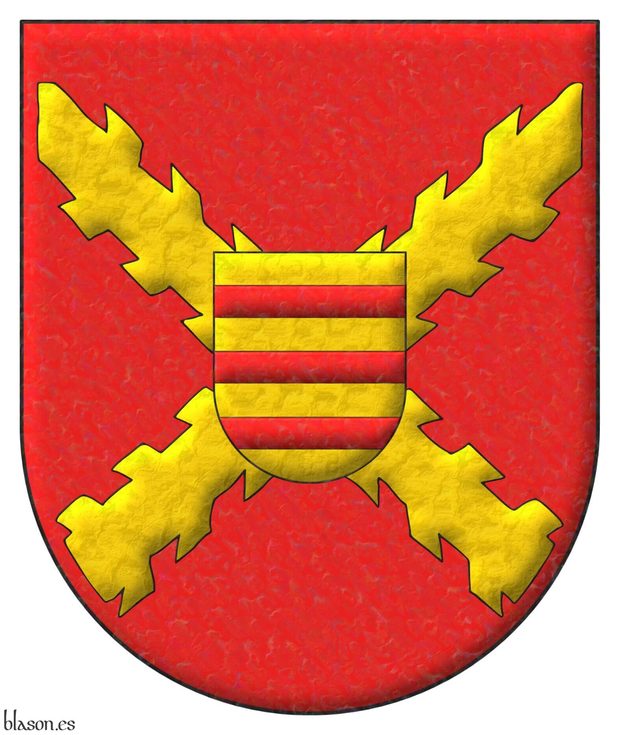
Gules, a cross of Burgundy Or; an inescutcheon Or, three bars Gules.
Escudo de gules, una cruz de Borgoña de oro; un escusón de oro, tres fajas de gules.
Arms painted by me, illuminated with lights and shadows, outlined in Sable, with a semi-circular outer contour and with a metal beaten finish.
Coat of arms of the Tercio Great Captain, 1st of the Spanish Legion, emblazoned by me. The inescutcheon represents the coat of arms of Gonzalo Fernandez de Cordoba, 1453-1515, known as «The Great Captain». During the Italian campaigns in the late 15th and early 16th centuries, especially during the wars of Naples, Gonzalo Fernandez de Cordoba reformed the Spanish army, adapting it to the new conditions of Renaissance warfare. He created a flexible tactical system based on the combination of pikemen, inspired by the Swiss; «espingarderos», forerunners of the arquebusiers; and «espadas» or shock troops, this combination would form the foundation of the future «Tercios».
Blazon keywords: Gules, Or, One, Three, Cross of Burgundy, Cross couped, Inescutcheon, Bar and Fess.
Style keywords: Outlined in sable, Illuminated, Semi-circular and Metal beaten.
Classification: Military, Interpreted, Boa and Coat of arms.
Bearer: Tercio Great Captain.


My heraldic channel at WhatsApp is whatsapp.com/channel/0029VbAV5sk3LdQbvWgP4p43 or blason.es/whatsapp.
Categories: Technology, Social networks, Lion, Rampant, Armed, Langued, Label, Behind the shield, Eight-pointed cross and Cross couped.
-
Language
-
Categories of heraldry
-
Divisions of the field
- Without divisions
- Party per pale
- Party per fess
- Party per bend
- Party per bend sinister
- Tierce
- Tierce sinister
- Tierced per pale
- Tierced per fess
- Tierced per bend
- Tierced pallwise inverted
- Quarterly
- Quarterly per saltire
- Gyronny
- Party per fess, the chief per pale
- Party per pale, the sinister per fess
- Party per fess, the base per pale
- Party per pale, the dexter per fess
- Chapé
- Chaussé
- Embrassé
- Contre-embrassé
- Party per chevron
- Enté
- Enté en point
- Flanched
-
Metals
-
Colours
-
Furs
-
Other tinctures
-
Ordinaries and sub-ordinaries
-
Diminutives of the ordinaries
-
Geometric charges
-
Composite ordinaries
-
Inanimate charges from Nature
Atom, Crescent, Diamond, Emerald, Estoile, Increscent, Lightning flash, Moon, Mount, Mullet, Mullet of four points, Orbital, Plough of Ursa Major, Rainbow, Ray of the sun, River, Sea, Snowflake, Sun, Sun in splendour, Sun of May, Trimount and Water.
-
Vegetal charges from Nature
Acorn, Apple, Apple tree, Ash, Bluebonnet, Camellia, Chrysanthemum, Cinquefoil, Cornflower, Dogwood flower, Double rose, Elm, Fleur de lis, Flower, Gourd, Holm oak, Hop cone, Kapok tree, Laurel, Lily, Linden, Lotus flower, Madonna lily, Oak, Olive tree, Palm tree, Pomegranate, Poplar leaf, Rose, Shamrock, Sunflower, Thistle, Tree, Tulip, Vine and Wheat.
-
Animal charges from Nature
Badger, Bald eagle, Barbel, Barn owl, Bear, Beaver, Beetle, Bighorn sheep, Blackbird, Boar, Brach hound, Bull, Doe, Dog, Dolphin, Dove, Eagle, Elephant, Falcon, Fish, Flame, Fly, Fox, Frog, Goat, Goldfinch, Goose, Heron, Horse, Hummingbird, Jaguar, Lark, Leopard, Lion, Lion passant, Lion rampant guardant, Lioness, Lynx, Male figure, Martlet, Merino ram, Owl, Panther, Parrot, Peacock, Pelican, Pelican in her piety, Puffin, Quetzal, Raven, Roe deer, Rooster, Savage, Seagull, Serpent, She-wolf, Stag, Starling, Talbot, Tyger, Vulture, Warren hound and Wolf.
-
Parts of natural charges
Arm, Beak, Branch, Caboshed, Chest, Claw, Covert, Dorsal fin, Eagle claw, Ermine spot, Escallop, Feather, Foot (palmiped), Foreleg, Forepaw, Hand, Head, Heart, Hoof, Leaf, Neck, Ostrich feather, Palm frond, Paw, Roe deers' attires, Shoulder, Sprig, Stags' attires, Stem, Swallow-tail, Tail, Tail addorsed, Tail fin, Talon, Tooth, Trunk, Trunk (elephant), Two hands clasped, Two wings in vol, Udder, Wheat spike, Wing and Wrist.
-
Artificial charges
Ace of spades, Anchor, Anvil, Arch, Arm vambraced, Armillary sphere, Arrow, Axe, Bell, Bell tower, Beret, Bonfire, Book, Bookmark, Bow, Bridge, Broken, Buckle, Cannon, Cannon dismounted, Cannon port, Canopy roof, Carbuncle, Castle, Celtic Trinity knot, Chain, Chess rooks, Church, Clarion, Clay pot, Closed book, Club, Comb, Compass rose, Conductor's baton, Cord, Covered cup, Crozier, Crucible, Cuffed, Cup, Cyclamor, Dagger, Double vajra, Drum, Ecclesiastical cap, Fanon, Federschwert, Fleam, Four crescents joined millsailwise, Galician granary, Garb, Gauntlet, Geometric solid, Grenade, Halberd, Hammer, Harp, Host, Hourglass, Key, Key ward, Knight, Knot, Lantern, Letter, Line, Loincloth, Menorah, Millrind, Millstone, Millwheel, Monstrance, Mortar, Mullet of six points pierced, Nail, Non-classic artifact, Norman ship, Number, Oar, Oil lamp, Open book, Page, Pair of scales, Parchment, Pestle, Piano, Pilgrim's staff, Plough share, Polish winged hussar, Port, Portcullis, Potent, Quill, Ribbon, Rosette of acanthus leaves, Sabre, Sackbut, Sail, Scroll, Scythe, Sheaf of tobacco, Ship, Skirt, Spear, Spear's head, Stairway, Star of David, Step, Sword, Symbol, Tetrahedron, Torch, Tower, Trident, Trumpet, Turret, Two-handed sword, Wagon-wheel, Water-bouget, Wheel, Winnowing fan and With a turret.
-
Immaterial charges
Angel, Archangel, Basilisk, Dragon, Dragon's head, Garuda, Golden fleece, Griffin, Heart enflamed, Mermaid, Our Lady of Mercy, Ouroboros, Paschal lamb, Pegasus, Phoenix, Sacred Heart of Jesus, Saint George, Sea-griffin, Trinity, Triton, Unicorn, Winged hand and Wyvern.
-
External elements
-
Heraldic creations
-
References
-
Formats
-
Keywords on this page
Behind the shield, Between, Pointed, Armed, Azure, Flag, Boa, Wreath, Charged, Crest, Ogee, Crown, Party per fess, Created, Cross, Eight-pointed cross, Cross flory, Cross patty, Cross couped, Quarterly, Four, Outlined in sable, Two, Emblem, Coat of arms, Personal, Gules, Illuminated, Interpreted, Chief, Mantling, Langued, Motto, Lion, Semi-circular, Military, Knights Templar, Or, Argent, Without divisions, Rampant, Religious, Sable, Vert, Crest and mantling, Freehand, Three, One and Helm.

